Work and working lives in a changing business environment - Assessment ID/CIPD_7CO01_21_01
VerifiedAdded on 2023/06/14
|26
|8243
|405
AI Summary
This assessment is designed to evidence achievement of the learning outcomes and assessment criteria for 7CO01 Work and working lives in a changing business environment. Learners are required to write four answers of approximately 1,000 words to the questions posed and submit them together in a single document. The total word count for the assessment will therefore be 4,000 words +/- 10%. The bibliography or list of references is not included in the total word count.
Contribute Materials
Your contribution can guide someone’s learning journey. Share your
documents today.
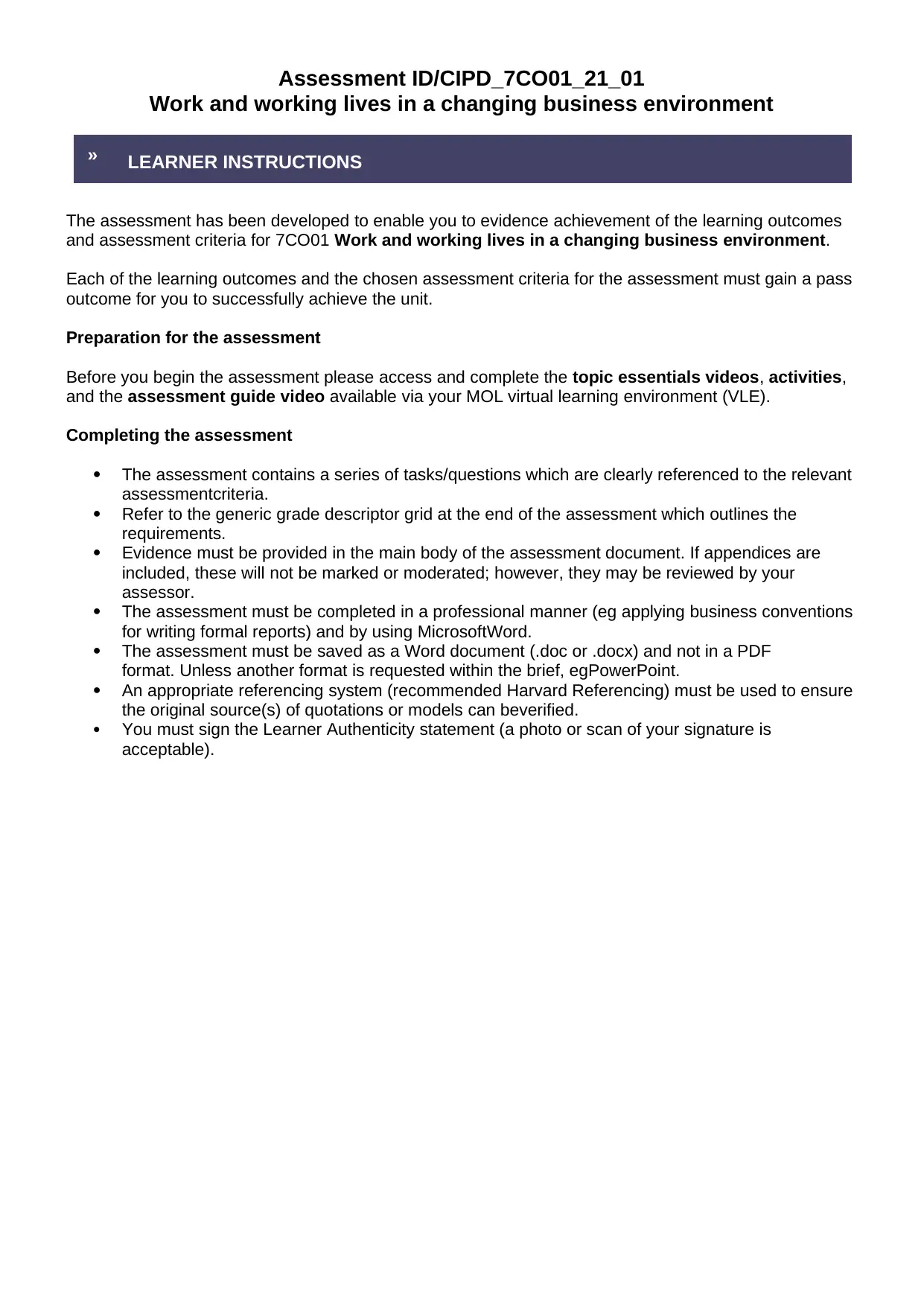
Assessment ID/CIPD_7CO01_21_01
Work and working lives in a changing business environment
» LEARNER INSTRUCTIONS
The assessment has been developed to enable you to evidence achievement of the learning outcomes
and assessment criteria for 7CO01 Work and working lives in a changing business environment.
Each of the learning outcomes and the chosen assessment criteria for the assessment must gain a pass
outcome for you to successfully achieve the unit.
Preparation for the assessment
Before you begin the assessment please access and complete the topic essentials videos, activities,
and the assessment guide video available via your MOL virtual learning environment (VLE).
Completing the assessment
The assessment contains a series of tasks/questions which are clearly referenced to the relevant
assessmentcriteria.
Refer to the generic grade descriptor grid at the end of the assessment which outlines the
requirements.
Evidence must be provided in the main body of the assessment document. If appendices are
included, these will not be marked or moderated; however, they may be reviewed by your
assessor.
The assessment must be completed in a professional manner (eg applying business conventions
for writing formal reports) and by using MicrosoftWord.
The assessment must be saved as a Word document (.doc or .docx) and not in a PDF
format. Unless another format is requested within the brief, egPowerPoint.
An appropriate referencing system (recommended Harvard Referencing) must be used to ensure
the original source(s) of quotations or models can beverified.
You must sign the Learner Authenticity statement (a photo or scan of your signature is
acceptable).
Work and working lives in a changing business environment
» LEARNER INSTRUCTIONS
The assessment has been developed to enable you to evidence achievement of the learning outcomes
and assessment criteria for 7CO01 Work and working lives in a changing business environment.
Each of the learning outcomes and the chosen assessment criteria for the assessment must gain a pass
outcome for you to successfully achieve the unit.
Preparation for the assessment
Before you begin the assessment please access and complete the topic essentials videos, activities,
and the assessment guide video available via your MOL virtual learning environment (VLE).
Completing the assessment
The assessment contains a series of tasks/questions which are clearly referenced to the relevant
assessmentcriteria.
Refer to the generic grade descriptor grid at the end of the assessment which outlines the
requirements.
Evidence must be provided in the main body of the assessment document. If appendices are
included, these will not be marked or moderated; however, they may be reviewed by your
assessor.
The assessment must be completed in a professional manner (eg applying business conventions
for writing formal reports) and by using MicrosoftWord.
The assessment must be saved as a Word document (.doc or .docx) and not in a PDF
format. Unless another format is requested within the brief, egPowerPoint.
An appropriate referencing system (recommended Harvard Referencing) must be used to ensure
the original source(s) of quotations or models can beverified.
You must sign the Learner Authenticity statement (a photo or scan of your signature is
acceptable).
Secure Best Marks with AI Grader
Need help grading? Try our AI Grader for instant feedback on your assignments.
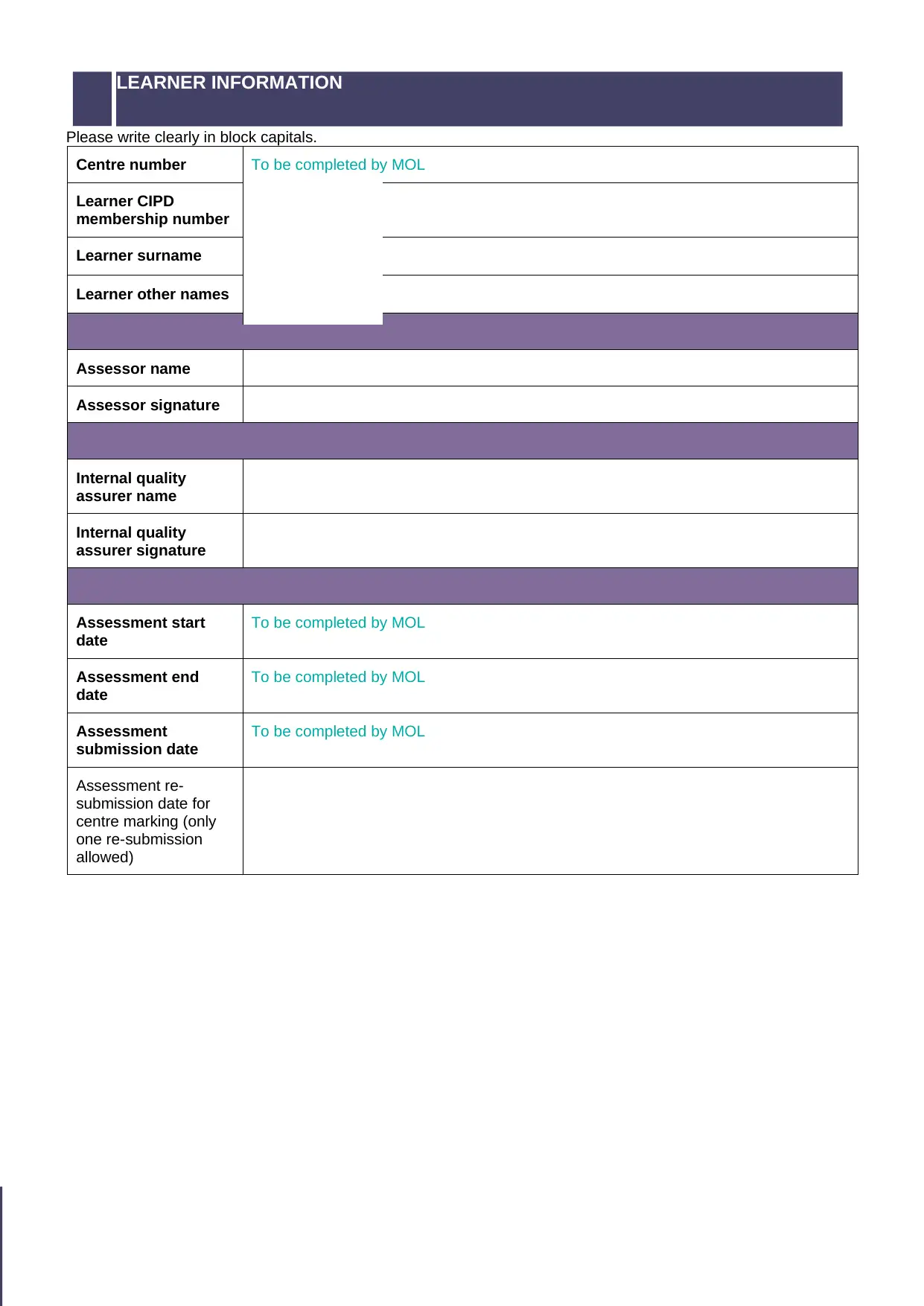
Please write clearly in block capitals.
Centre number To be completed by MOL
Learner CIPD
membership number
Learner surname
Learner other names
Assessor name
Assessor signature
Internal quality
assurer name
Internal quality
assurer signature
Assessment start
date
To be completed by MOL
Assessment end
date
To be completed by MOL
Assessment
submission date
To be completed by MOL
Assessment re-
submission date for
centre marking (only
one re-submission
allowed)
LEARNER INFORMATION
Centre number To be completed by MOL
Learner CIPD
membership number
Learner surname
Learner other names
Assessor name
Assessor signature
Internal quality
assurer name
Internal quality
assurer signature
Assessment start
date
To be completed by MOL
Assessment end
date
To be completed by MOL
Assessment
submission date
To be completed by MOL
Assessment re-
submission date for
centre marking (only
one re-submission
allowed)
LEARNER INFORMATION
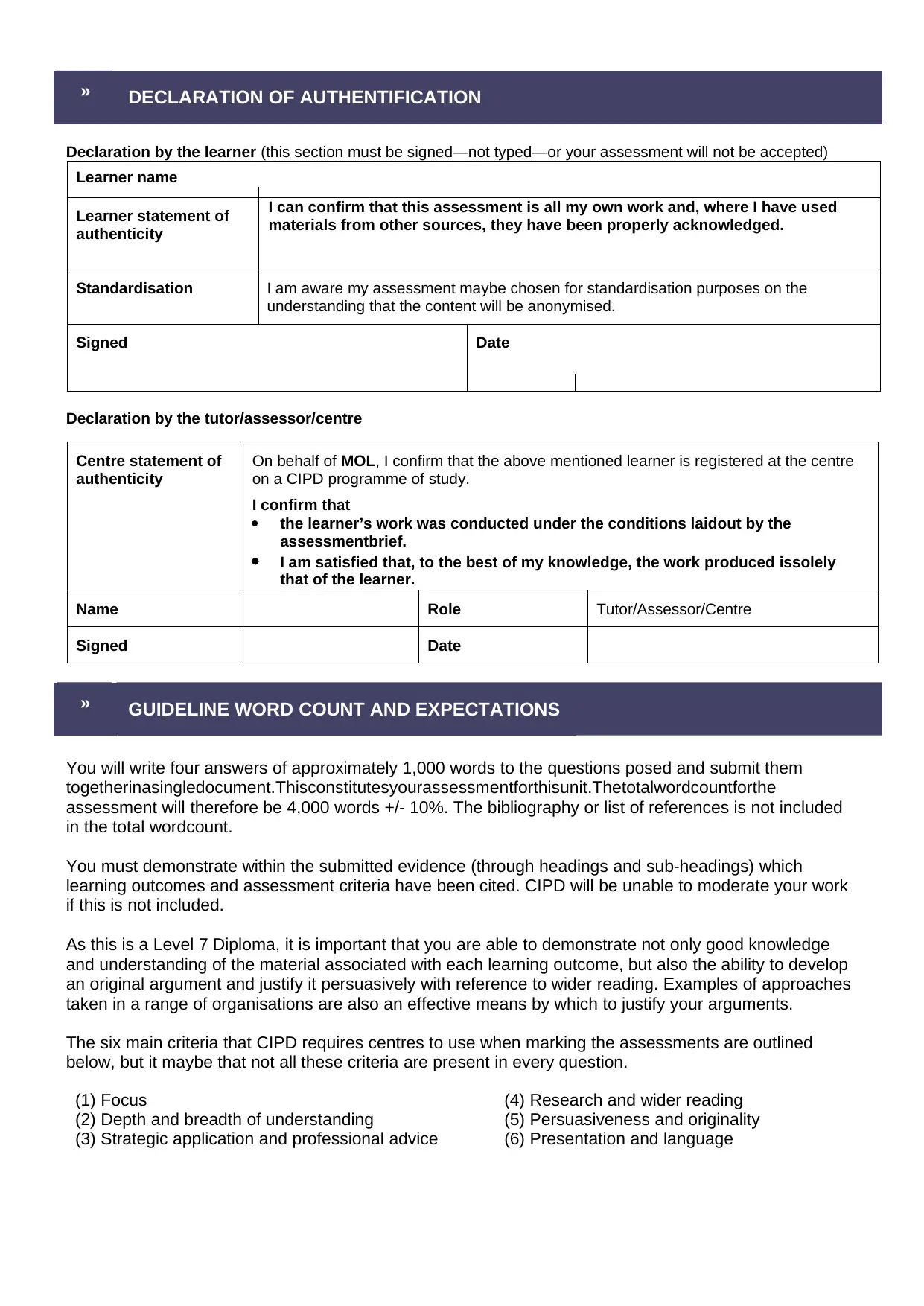
» DECLARATION OF AUTHENTIFICATION
Declaration by the learner (this section must be signed—not typed—or your assessment will not be accepted)
Learner name
Learner statement of
authenticity
I can confirm that this assessment is all my own work and, where I have used
materials from other sources, they have been properly acknowledged.
Standardisation I am aware my assessment maybe chosen for standardisation purposes on the
understanding that the content will be anonymised.
Signed Date
Declaration by the tutor/assessor/centre
Centre statement of
authenticity
On behalf of MOL, I confirm that the above mentioned learner is registered at the centre
on a CIPD programme of study.
I confirm that
the learner’s work was conducted under the conditions laidout by the
assessmentbrief.
I am satisfied that, to the best of my knowledge, the work produced issolely
that of the learner.
Name Role Tutor/Assessor/Centre
Signed Date
» GUIDELINE WORD COUNT AND EXPECTATIONS
You will write four answers of approximately 1,000 words to the questions posed and submit them
togetherinasingledocument.Thisconstitutesyourassessmentforthisunit.Thetotalwordcountforthe
assessment will therefore be 4,000 words +/- 10%. The bibliography or list of references is not included
in the total wordcount.
You must demonstrate within the submitted evidence (through headings and sub-headings) which
learning outcomes and assessment criteria have been cited. CIPD will be unable to moderate your work
if this is not included.
As this is a Level 7 Diploma, it is important that you are able to demonstrate not only good knowledge
and understanding of the material associated with each learning outcome, but also the ability to develop
an original argument and justify it persuasively with reference to wider reading. Examples of approaches
taken in a range of organisations are also an effective means by which to justify your arguments.
The six main criteria that CIPD requires centres to use when marking the assessments are outlined
below, but it maybe that not all these criteria are present in every question.
(1) Focus (4) Research and wider reading
(2) Depth and breadth of understanding (5) Persuasiveness and originality
(3) Strategic application and professional advice (6) Presentation and language
Declaration by the learner (this section must be signed—not typed—or your assessment will not be accepted)
Learner name
Learner statement of
authenticity
I can confirm that this assessment is all my own work and, where I have used
materials from other sources, they have been properly acknowledged.
Standardisation I am aware my assessment maybe chosen for standardisation purposes on the
understanding that the content will be anonymised.
Signed Date
Declaration by the tutor/assessor/centre
Centre statement of
authenticity
On behalf of MOL, I confirm that the above mentioned learner is registered at the centre
on a CIPD programme of study.
I confirm that
the learner’s work was conducted under the conditions laidout by the
assessmentbrief.
I am satisfied that, to the best of my knowledge, the work produced issolely
that of the learner.
Name Role Tutor/Assessor/Centre
Signed Date
» GUIDELINE WORD COUNT AND EXPECTATIONS
You will write four answers of approximately 1,000 words to the questions posed and submit them
togetherinasingledocument.Thisconstitutesyourassessmentforthisunit.Thetotalwordcountforthe
assessment will therefore be 4,000 words +/- 10%. The bibliography or list of references is not included
in the total wordcount.
You must demonstrate within the submitted evidence (through headings and sub-headings) which
learning outcomes and assessment criteria have been cited. CIPD will be unable to moderate your work
if this is not included.
As this is a Level 7 Diploma, it is important that you are able to demonstrate not only good knowledge
and understanding of the material associated with each learning outcome, but also the ability to develop
an original argument and justify it persuasively with reference to wider reading. Examples of approaches
taken in a range of organisations are also an effective means by which to justify your arguments.
The six main criteria that CIPD requires centres to use when marking the assessments are outlined
below, but it maybe that not all these criteria are present in every question.
(1) Focus (4) Research and wider reading
(2) Depth and breadth of understanding (5) Persuasiveness and originality
(3) Strategic application and professional advice (6) Presentation and language
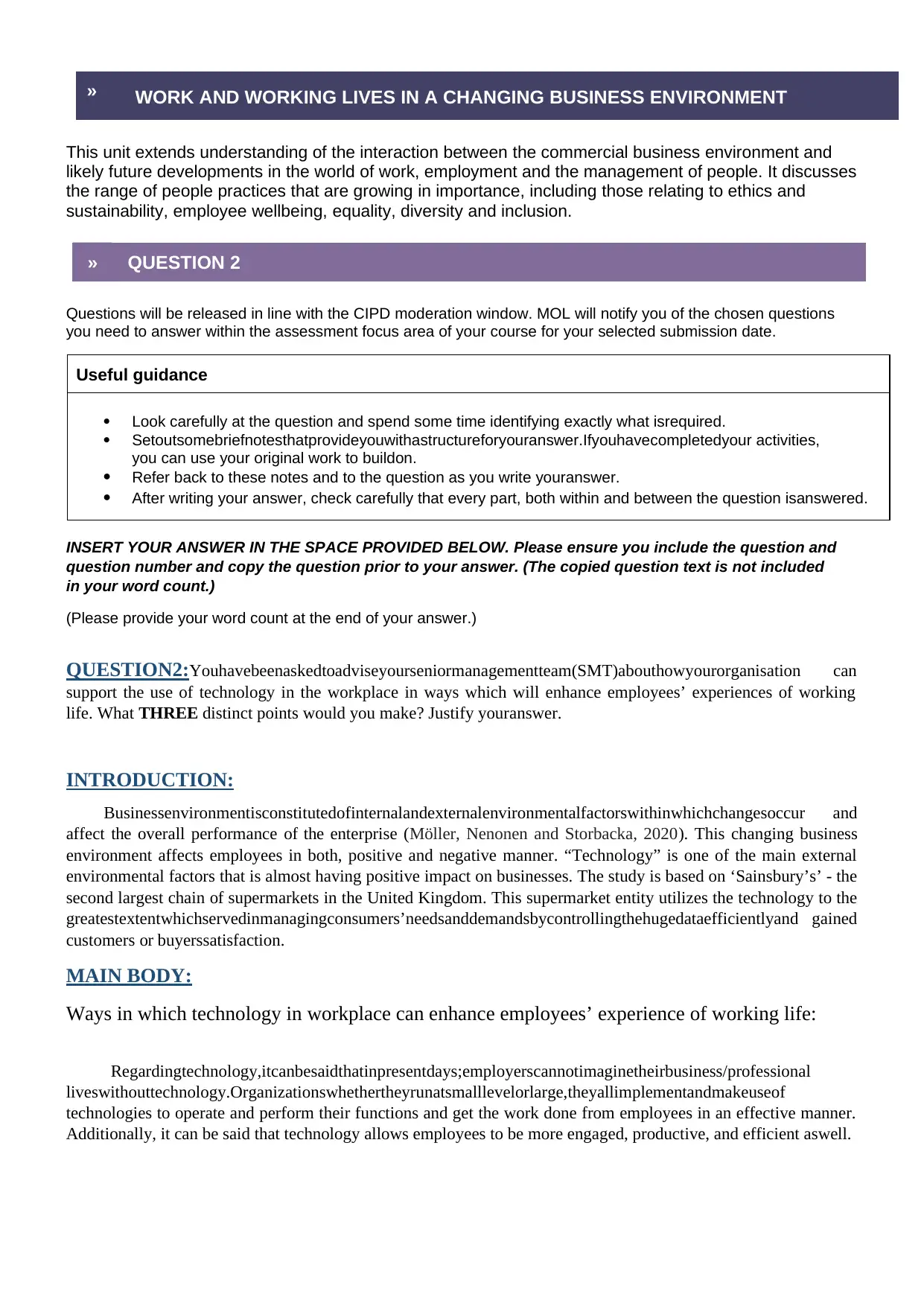
» WORK AND WORKING LIVES IN A CHANGING BUSINESS ENVIRONMENT
This unit extends understanding of the interaction between the commercial business environment and
likely future developments in the world of work, employment and the management of people. It discusses
the range of people practices that are growing in importance, including those relating to ethics and
sustainability, employee wellbeing, equality, diversity and inclusion.
» QUESTION 2
Questions will be released in line with the CIPD moderation window. MOL will notify you of the chosen questions
you need to answer within the assessment focus area of your course for your selected submission date.
Useful guidance
Look carefully at the question and spend some time identifying exactly what isrequired.
Setoutsomebriefnotesthatprovideyouwithastructureforyouranswer.Ifyouhavecompletedyour activities,
you can use your original work to buildon.
Refer back to these notes and to the question as you write youranswer.
After writing your answer, check carefully that every part, both within and between the question isanswered.
INSERT YOUR ANSWER IN THE SPACE PROVIDED BELOW. Please ensure you include the question and
question number and copy the question prior to your answer. (The copied question text is not included
in your word count.)
(Please provide your word count at the end of your answer.)
QUESTION2:Youhavebeenaskedtoadviseyourseniormanagementteam(SMT)abouthowyourorganisation can
support the use of technology in the workplace in ways which will enhance employees’ experiences of working
life. What THREE distinct points would you make? Justify youranswer.
INTRODUCTION:
Businessenvironmentisconstitutedofinternalandexternalenvironmentalfactorswithinwhichchangesoccur and
affect the overall performance of the enterprise (Möller, Nenonen and Storbacka, 2020). This changing business
environment affects employees in both, positive and negative manner. “Technology” is one of the main external
environmental factors that is almost having positive impact on businesses. The study is based on ‘Sainsbury’s’ - the
second largest chain of supermarkets in the United Kingdom. This supermarket entity utilizes the technology to the
greatestextentwhichservedinmanagingconsumers’needsanddemandsbycontrollingthehugedataefficientlyand gained
customers or buyerssatisfaction.
MAIN BODY:
Ways in which technology in workplace can enhance employees’ experience of working life:
Regardingtechnology,itcanbesaidthatinpresentdays;employerscannotimaginetheirbusiness/professional
liveswithouttechnology.Organizationswhethertheyrunatsmalllevelorlarge,theyallimplementandmakeuseof
technologies to operate and perform their functions and get the work done from employees in an effective manner.
Additionally, it can be said that technology allows employees to be more engaged, productive, and efficient aswell.
This unit extends understanding of the interaction between the commercial business environment and
likely future developments in the world of work, employment and the management of people. It discusses
the range of people practices that are growing in importance, including those relating to ethics and
sustainability, employee wellbeing, equality, diversity and inclusion.
» QUESTION 2
Questions will be released in line with the CIPD moderation window. MOL will notify you of the chosen questions
you need to answer within the assessment focus area of your course for your selected submission date.
Useful guidance
Look carefully at the question and spend some time identifying exactly what isrequired.
Setoutsomebriefnotesthatprovideyouwithastructureforyouranswer.Ifyouhavecompletedyour activities,
you can use your original work to buildon.
Refer back to these notes and to the question as you write youranswer.
After writing your answer, check carefully that every part, both within and between the question isanswered.
INSERT YOUR ANSWER IN THE SPACE PROVIDED BELOW. Please ensure you include the question and
question number and copy the question prior to your answer. (The copied question text is not included
in your word count.)
(Please provide your word count at the end of your answer.)
QUESTION2:Youhavebeenaskedtoadviseyourseniormanagementteam(SMT)abouthowyourorganisation can
support the use of technology in the workplace in ways which will enhance employees’ experiences of working
life. What THREE distinct points would you make? Justify youranswer.
INTRODUCTION:
Businessenvironmentisconstitutedofinternalandexternalenvironmentalfactorswithinwhichchangesoccur and
affect the overall performance of the enterprise (Möller, Nenonen and Storbacka, 2020). This changing business
environment affects employees in both, positive and negative manner. “Technology” is one of the main external
environmental factors that is almost having positive impact on businesses. The study is based on ‘Sainsbury’s’ - the
second largest chain of supermarkets in the United Kingdom. This supermarket entity utilizes the technology to the
greatestextentwhichservedinmanagingconsumers’needsanddemandsbycontrollingthehugedataefficientlyand gained
customers or buyerssatisfaction.
MAIN BODY:
Ways in which technology in workplace can enhance employees’ experience of working life:
Regardingtechnology,itcanbesaidthatinpresentdays;employerscannotimaginetheirbusiness/professional
liveswithouttechnology.Organizationswhethertheyrunatsmalllevelorlarge,theyallimplementandmakeuseof
technologies to operate and perform their functions and get the work done from employees in an effective manner.
Additionally, it can be said that technology allows employees to be more engaged, productive, and efficient aswell.
Secure Best Marks with AI Grader
Need help grading? Try our AI Grader for instant feedback on your assignments.
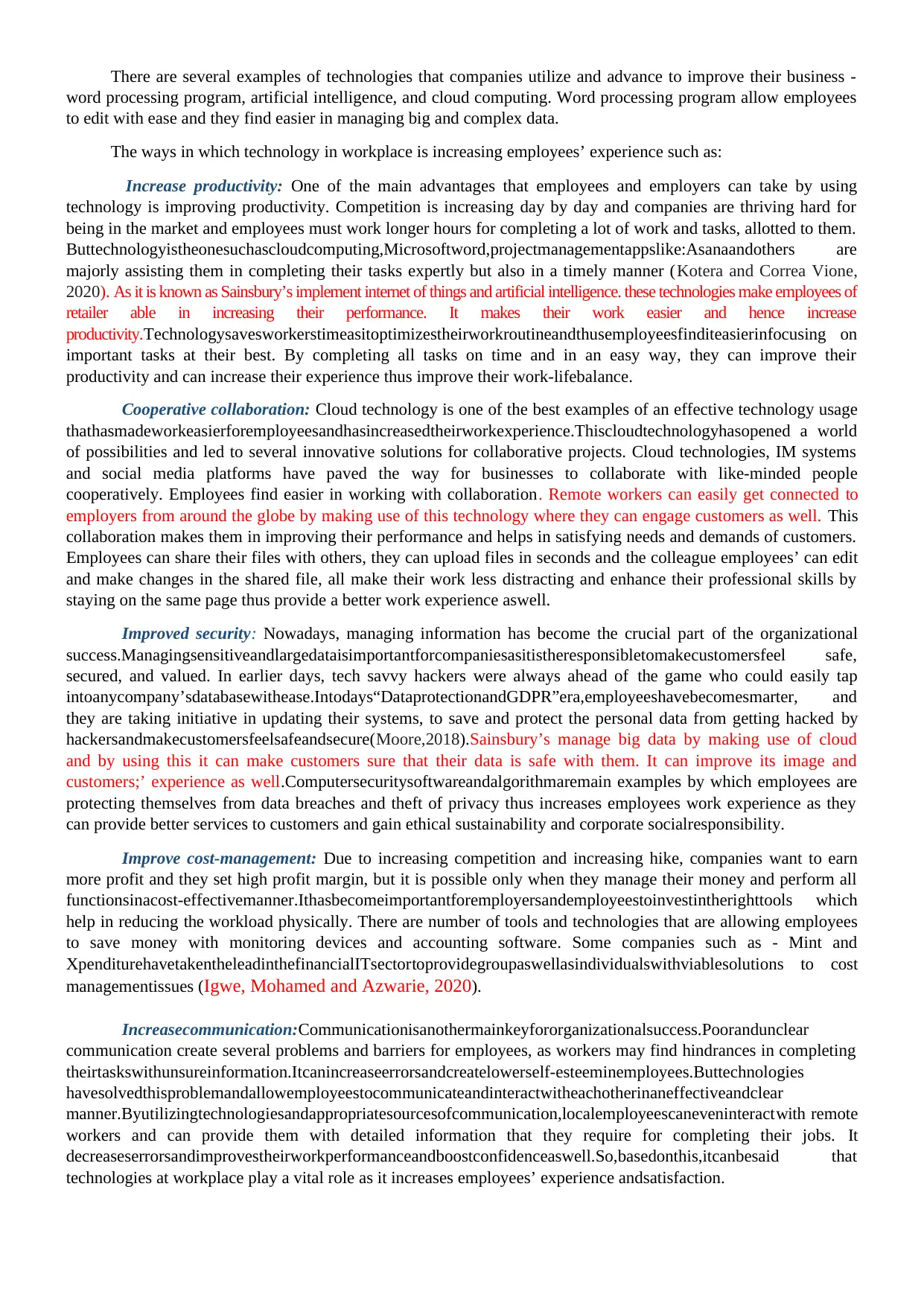
There are several examples of technologies that companies utilize and advance to improve their business -
word processing program, artificial intelligence, and cloud computing. Word processing program allow employees
to edit with ease and they find easier in managing big and complex data.
The ways in which technology in workplace is increasing employees’ experience such as:
Increase productivity: One of the main advantages that employees and employers can take by using
technology is improving productivity. Competition is increasing day by day and companies are thriving hard for
being in the market and employees must work longer hours for completing a lot of work and tasks, allotted to them.
Buttechnologyistheonesuchascloudcomputing,Microsoftword,projectmanagementappslike:Asanaandothers are
majorly assisting them in completing their tasks expertly but also in a timely manner (Kotera and Correa Vione,
2020). As it is known as Sainsbury’s implement internet of things and artificial intelligence. these technologies make employees of
retailer able in increasing their performance. It makes their work easier and hence increase
productivity.Technologysavesworkerstimeasitoptimizestheirworkroutineandthusemployeesfinditeasierinfocusing on
important tasks at their best. By completing all tasks on time and in an easy way, they can improve their
productivity and can increase their experience thus improve their work-lifebalance.
Cooperative collaboration: Cloud technology is one of the best examples of an effective technology usage
thathasmadeworkeasierforemployeesandhasincreasedtheirworkexperience.Thiscloudtechnologyhasopened a world
of possibilities and led to several innovative solutions for collaborative projects. Cloud technologies, IM systems
and social media platforms have paved the way for businesses to collaborate with like-minded people
cooperatively. Employees find easier in working with collaboration. Remote workers can easily get connected to
employers from around the globe by making use of this technology where they can engage customers as well. This
collaboration makes them in improving their performance and helps in satisfying needs and demands of customers.
Employees can share their files with others, they can upload files in seconds and the colleague employees’ can edit
and make changes in the shared file, all make their work less distracting and enhance their professional skills by
staying on the same page thus provide a better work experience aswell.
Improved security: Nowadays, managing information has become the crucial part of the organizational
success.Managingsensitiveandlargedataisimportantforcompaniesasitistheresponsibletomakecustomersfeel safe,
secured, and valued. In earlier days, tech savvy hackers were always ahead of the game who could easily tap
intoanycompany’sdatabasewithease.Intodays“DataprotectionandGDPR”era,employeeshavebecomesmarter, and
they are taking initiative in updating their systems, to save and protect the personal data from getting hacked by
hackersandmakecustomersfeelsafeandsecure(Moore,2018).Sainsbury’s manage big data by making use of cloud
and by using this it can make customers sure that their data is safe with them. It can improve its image and
customers;’ experience as well.Computersecuritysoftwareandalgorithmaremain examples by which employees are
protecting themselves from data breaches and theft of privacy thus increases employees work experience as they
can provide better services to customers and gain ethical sustainability and corporate socialresponsibility.
Improve cost-management: Due to increasing competition and increasing hike, companies want to earn
more profit and they set high profit margin, but it is possible only when they manage their money and perform all
functionsinacost-effectivemanner.Ithasbecomeimportantforemployersandemployeestoinvestintherighttools which
help in reducing the workload physically. There are number of tools and technologies that are allowing employees
to save money with monitoring devices and accounting software. Some companies such as - Mint and
XpenditurehavetakentheleadinthefinancialITsectortoprovidegroupaswellasindividualswithviablesolutions to cost
managementissues (Igwe, Mohamed and Azwarie, 2020).
Increasecommunication:Communicationisanothermainkeyfororganizationalsuccess.Poorandunclear
communication create several problems and barriers for employees, as workers may find hindrances in completing
theirtaskswithunsureinformation.Itcanincreaseerrorsandcreatelowerself-esteeminemployees.Buttechnologies
havesolvedthisproblemandallowemployeestocommunicateandinteractwitheachotherinaneffectiveandclear
manner.Byutilizingtechnologiesandappropriatesourcesofcommunication,localemployeescaneveninteractwith remote
workers and can provide them with detailed information that they require for completing their jobs. It
decreaseserrorsandimprovestheirworkperformanceandboostconfidenceaswell.So,basedonthis,itcanbesaid that
technologies at workplace play a vital role as it increases employees’ experience andsatisfaction.
word processing program, artificial intelligence, and cloud computing. Word processing program allow employees
to edit with ease and they find easier in managing big and complex data.
The ways in which technology in workplace is increasing employees’ experience such as:
Increase productivity: One of the main advantages that employees and employers can take by using
technology is improving productivity. Competition is increasing day by day and companies are thriving hard for
being in the market and employees must work longer hours for completing a lot of work and tasks, allotted to them.
Buttechnologyistheonesuchascloudcomputing,Microsoftword,projectmanagementappslike:Asanaandothers are
majorly assisting them in completing their tasks expertly but also in a timely manner (Kotera and Correa Vione,
2020). As it is known as Sainsbury’s implement internet of things and artificial intelligence. these technologies make employees of
retailer able in increasing their performance. It makes their work easier and hence increase
productivity.Technologysavesworkerstimeasitoptimizestheirworkroutineandthusemployeesfinditeasierinfocusing on
important tasks at their best. By completing all tasks on time and in an easy way, they can improve their
productivity and can increase their experience thus improve their work-lifebalance.
Cooperative collaboration: Cloud technology is one of the best examples of an effective technology usage
thathasmadeworkeasierforemployeesandhasincreasedtheirworkexperience.Thiscloudtechnologyhasopened a world
of possibilities and led to several innovative solutions for collaborative projects. Cloud technologies, IM systems
and social media platforms have paved the way for businesses to collaborate with like-minded people
cooperatively. Employees find easier in working with collaboration. Remote workers can easily get connected to
employers from around the globe by making use of this technology where they can engage customers as well. This
collaboration makes them in improving their performance and helps in satisfying needs and demands of customers.
Employees can share their files with others, they can upload files in seconds and the colleague employees’ can edit
and make changes in the shared file, all make their work less distracting and enhance their professional skills by
staying on the same page thus provide a better work experience aswell.
Improved security: Nowadays, managing information has become the crucial part of the organizational
success.Managingsensitiveandlargedataisimportantforcompaniesasitistheresponsibletomakecustomersfeel safe,
secured, and valued. In earlier days, tech savvy hackers were always ahead of the game who could easily tap
intoanycompany’sdatabasewithease.Intodays“DataprotectionandGDPR”era,employeeshavebecomesmarter, and
they are taking initiative in updating their systems, to save and protect the personal data from getting hacked by
hackersandmakecustomersfeelsafeandsecure(Moore,2018).Sainsbury’s manage big data by making use of cloud
and by using this it can make customers sure that their data is safe with them. It can improve its image and
customers;’ experience as well.Computersecuritysoftwareandalgorithmaremain examples by which employees are
protecting themselves from data breaches and theft of privacy thus increases employees work experience as they
can provide better services to customers and gain ethical sustainability and corporate socialresponsibility.
Improve cost-management: Due to increasing competition and increasing hike, companies want to earn
more profit and they set high profit margin, but it is possible only when they manage their money and perform all
functionsinacost-effectivemanner.Ithasbecomeimportantforemployersandemployeestoinvestintherighttools which
help in reducing the workload physically. There are number of tools and technologies that are allowing employees
to save money with monitoring devices and accounting software. Some companies such as - Mint and
XpenditurehavetakentheleadinthefinancialITsectortoprovidegroupaswellasindividualswithviablesolutions to cost
managementissues (Igwe, Mohamed and Azwarie, 2020).
Increasecommunication:Communicationisanothermainkeyfororganizationalsuccess.Poorandunclear
communication create several problems and barriers for employees, as workers may find hindrances in completing
theirtaskswithunsureinformation.Itcanincreaseerrorsandcreatelowerself-esteeminemployees.Buttechnologies
havesolvedthisproblemandallowemployeestocommunicateandinteractwitheachotherinaneffectiveandclear
manner.Byutilizingtechnologiesandappropriatesourcesofcommunication,localemployeescaneveninteractwith remote
workers and can provide them with detailed information that they require for completing their jobs. It
decreaseserrorsandimprovestheirworkperformanceandboostconfidenceaswell.So,basedonthis,itcanbesaid that
technologies at workplace play a vital role as it increases employees’ experience andsatisfaction.
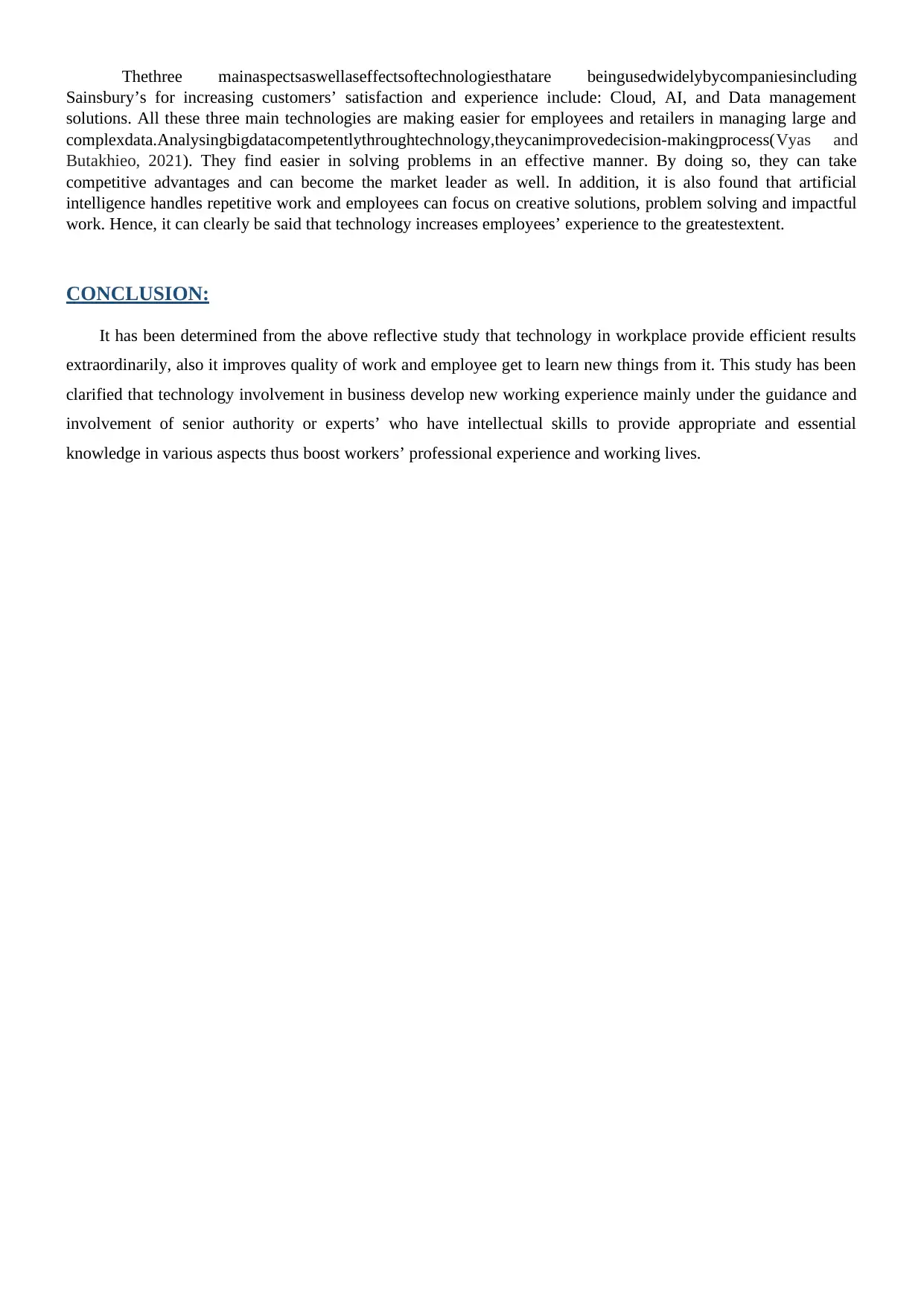
Thethree mainaspectsaswellaseffectsoftechnologiesthatare beingusedwidelybycompaniesincluding
Sainsbury’s for increasing customers’ satisfaction and experience include: Cloud, AI, and Data management
solutions. All these three main technologies are making easier for employees and retailers in managing large and
complexdata.Analysingbigdatacompetentlythroughtechnology,theycanimprovedecision-makingprocess(Vyas and
Butakhieo, 2021). They find easier in solving problems in an effective manner. By doing so, they can take
competitive advantages and can become the market leader as well. In addition, it is also found that artificial
intelligence handles repetitive work and employees can focus on creative solutions, problem solving and impactful
work. Hence, it can clearly be said that technology increases employees’ experience to the greatestextent.
CONCLUSION:
It has been determined from the above reflective study that technology in workplace provide efficient results
extraordinarily, also it improves quality of work and employee get to learn new things from it. This study has been
clarified that technology involvement in business develop new working experience mainly under the guidance and
involvement of senior authority or experts’ who have intellectual skills to provide appropriate and essential
knowledge in various aspects thus boost workers’ professional experience and working lives.
Sainsbury’s for increasing customers’ satisfaction and experience include: Cloud, AI, and Data management
solutions. All these three main technologies are making easier for employees and retailers in managing large and
complexdata.Analysingbigdatacompetentlythroughtechnology,theycanimprovedecision-makingprocess(Vyas and
Butakhieo, 2021). They find easier in solving problems in an effective manner. By doing so, they can take
competitive advantages and can become the market leader as well. In addition, it is also found that artificial
intelligence handles repetitive work and employees can focus on creative solutions, problem solving and impactful
work. Hence, it can clearly be said that technology increases employees’ experience to the greatestextent.
CONCLUSION:
It has been determined from the above reflective study that technology in workplace provide efficient results
extraordinarily, also it improves quality of work and employee get to learn new things from it. This study has been
clarified that technology involvement in business develop new working experience mainly under the guidance and
involvement of senior authority or experts’ who have intellectual skills to provide appropriate and essential
knowledge in various aspects thus boost workers’ professional experience and working lives.
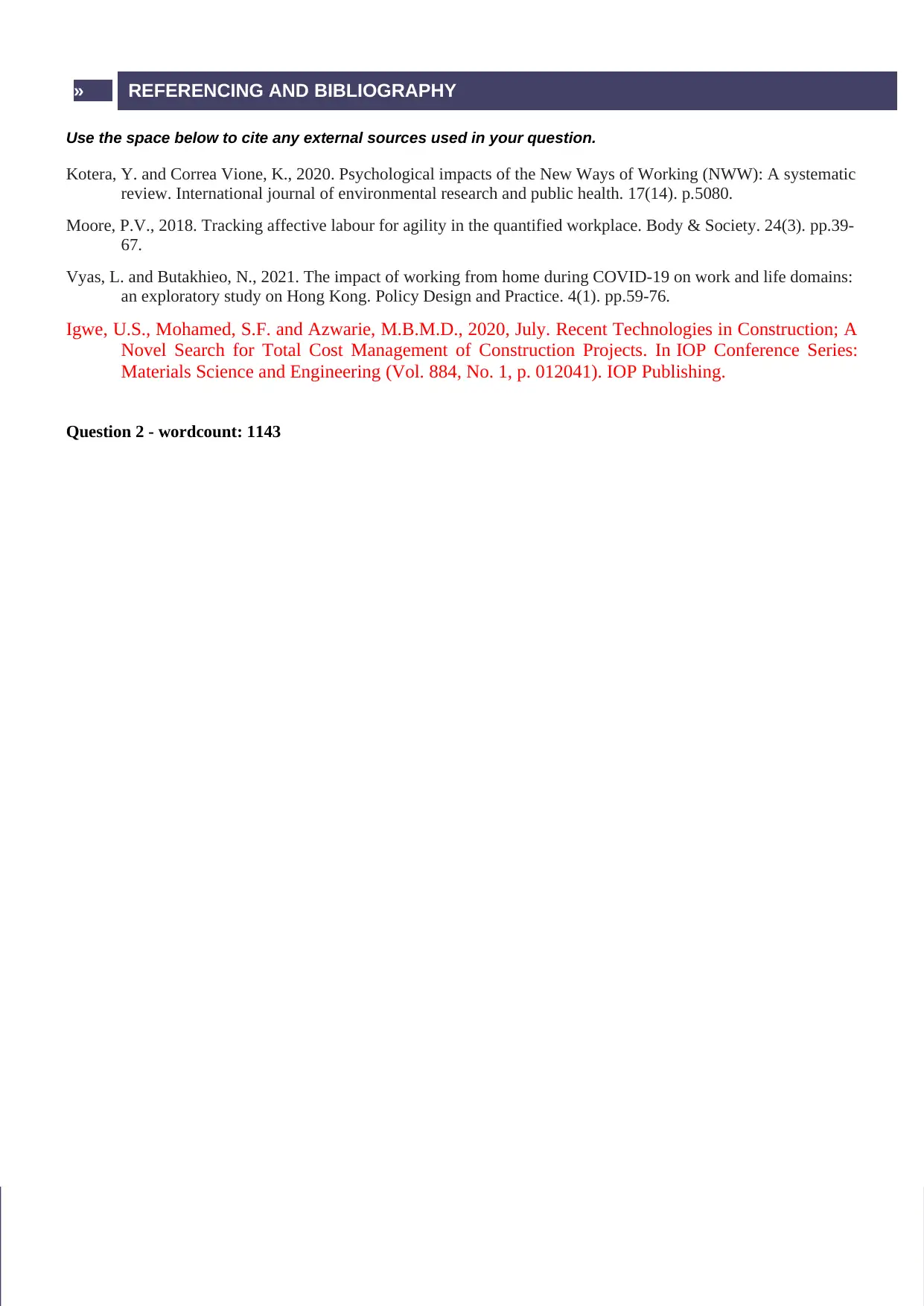
» REFERENCING AND BIBLIOGRAPHY
Use the space below to cite any external sources used in your question.
Kotera, Y. and Correa Vione, K., 2020. Psychological impacts of the New Ways of Working (NWW): A systematic
review. International journal of environmental research and public health. 17(14). p.5080.
Moore, P.V., 2018. Tracking affective labour for agility in the quantified workplace. Body & Society. 24(3). pp.39-
67.
Vyas, L. and Butakhieo, N., 2021. The impact of working from home during COVID-19 on work and life domains:
an exploratory study on Hong Kong. Policy Design and Practice. 4(1). pp.59-76.
Igwe, U.S., Mohamed, S.F. and Azwarie, M.B.M.D., 2020, July. Recent Technologies in Construction; A
Novel Search for Total Cost Management of Construction Projects. In IOP Conference Series:
Materials Science and Engineering (Vol. 884, No. 1, p. 012041). IOP Publishing.
Question 2 - wordcount: 1143
Use the space below to cite any external sources used in your question.
Kotera, Y. and Correa Vione, K., 2020. Psychological impacts of the New Ways of Working (NWW): A systematic
review. International journal of environmental research and public health. 17(14). p.5080.
Moore, P.V., 2018. Tracking affective labour for agility in the quantified workplace. Body & Society. 24(3). pp.39-
67.
Vyas, L. and Butakhieo, N., 2021. The impact of working from home during COVID-19 on work and life domains:
an exploratory study on Hong Kong. Policy Design and Practice. 4(1). pp.59-76.
Igwe, U.S., Mohamed, S.F. and Azwarie, M.B.M.D., 2020, July. Recent Technologies in Construction; A
Novel Search for Total Cost Management of Construction Projects. In IOP Conference Series:
Materials Science and Engineering (Vol. 884, No. 1, p. 012041). IOP Publishing.
Question 2 - wordcount: 1143
Paraphrase This Document
Need a fresh take? Get an instant paraphrase of this document with our AI Paraphraser
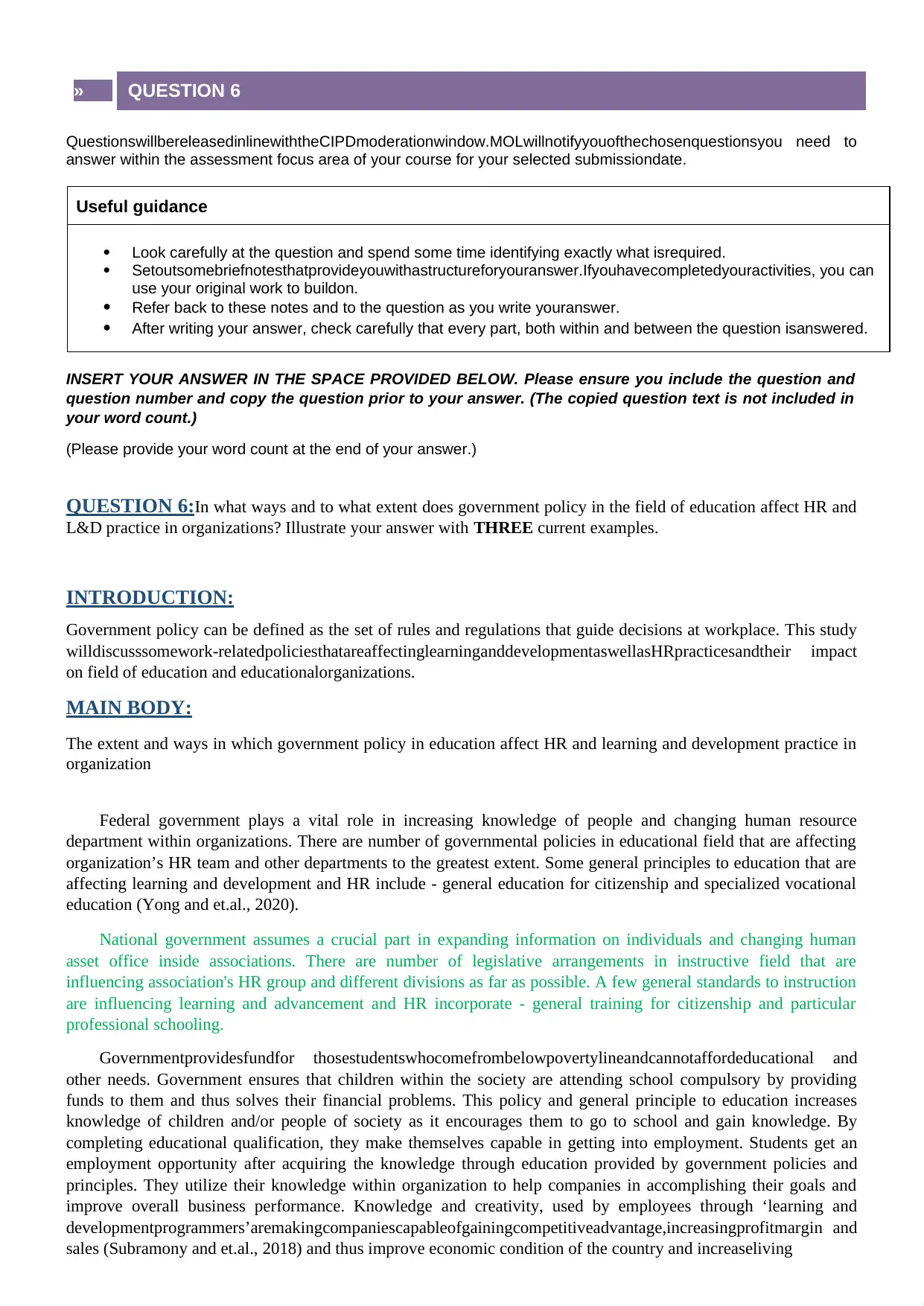
» QUESTION 6
QuestionswillbereleasedinlinewiththeCIPDmoderationwindow.MOLwillnotifyyouofthechosenquestionsyou need to
answer within the assessment focus area of your course for your selected submissiondate.
Useful guidance
Look carefully at the question and spend some time identifying exactly what isrequired.
Setoutsomebriefnotesthatprovideyouwithastructureforyouranswer.Ifyouhavecompletedyouractivities, you can
use your original work to buildon.
Refer back to these notes and to the question as you write youranswer.
After writing your answer, check carefully that every part, both within and between the question isanswered.
INSERT YOUR ANSWER IN THE SPACE PROVIDED BELOW. Please ensure you include the question and
question number and copy the question prior to your answer. (The copied question text is not included in
your word count.)
(Please provide your word count at the end of your answer.)
QUESTION 6:In what ways and to what extent does government policy in the field of education affect HR and
L&D practice in organizations? Illustrate your answer with THREE current examples.
INTRODUCTION:
Government policy can be defined as the set of rules and regulations that guide decisions at workplace. This study
willdiscusssomework-relatedpoliciesthatareaffectinglearninganddevelopmentaswellasHRpracticesandtheir impact
on field of education and educationalorganizations.
MAIN BODY:
The extent and ways in which government policy in education affect HR and learning and development practice in
organization
Federal government plays a vital role in increasing knowledge of people and changing human resource
department within organizations. There are number of governmental policies in educational field that are affecting
organization’s HR team and other departments to the greatest extent. Some general principles to education that are
affecting learning and development and HR include - general education for citizenship and specialized vocational
education (Yong and et.al., 2020).
National government assumes a crucial part in expanding information on individuals and changing human
asset office inside associations. There are number of legislative arrangements in instructive field that are
influencing association's HR group and different divisions as far as possible. A few general standards to instruction
are influencing learning and advancement and HR incorporate - general training for citizenship and particular
professional schooling.
Governmentprovidesfundfor thosestudentswhocomefrombelowpovertylineandcannotaffordeducational and
other needs. Government ensures that children within the society are attending school compulsory by providing
funds to them and thus solves their financial problems. This policy and general principle to education increases
knowledge of children and/or people of society as it encourages them to go to school and gain knowledge. By
completing educational qualification, they make themselves capable in getting into employment. Students get an
employment opportunity after acquiring the knowledge through education provided by government policies and
principles. They utilize their knowledge within organization to help companies in accomplishing their goals and
improve overall business performance. Knowledge and creativity, used by employees through ‘learning and
developmentprogrammers’aremakingcompaniescapableofgainingcompetitiveadvantage,increasingprofitmargin and
sales (Subramony and et.al., 2018) and thus improve economic condition of the country and increaseliving
QuestionswillbereleasedinlinewiththeCIPDmoderationwindow.MOLwillnotifyyouofthechosenquestionsyou need to
answer within the assessment focus area of your course for your selected submissiondate.
Useful guidance
Look carefully at the question and spend some time identifying exactly what isrequired.
Setoutsomebriefnotesthatprovideyouwithastructureforyouranswer.Ifyouhavecompletedyouractivities, you can
use your original work to buildon.
Refer back to these notes and to the question as you write youranswer.
After writing your answer, check carefully that every part, both within and between the question isanswered.
INSERT YOUR ANSWER IN THE SPACE PROVIDED BELOW. Please ensure you include the question and
question number and copy the question prior to your answer. (The copied question text is not included in
your word count.)
(Please provide your word count at the end of your answer.)
QUESTION 6:In what ways and to what extent does government policy in the field of education affect HR and
L&D practice in organizations? Illustrate your answer with THREE current examples.
INTRODUCTION:
Government policy can be defined as the set of rules and regulations that guide decisions at workplace. This study
willdiscusssomework-relatedpoliciesthatareaffectinglearninganddevelopmentaswellasHRpracticesandtheir impact
on field of education and educationalorganizations.
MAIN BODY:
The extent and ways in which government policy in education affect HR and learning and development practice in
organization
Federal government plays a vital role in increasing knowledge of people and changing human resource
department within organizations. There are number of governmental policies in educational field that are affecting
organization’s HR team and other departments to the greatest extent. Some general principles to education that are
affecting learning and development and HR include - general education for citizenship and specialized vocational
education (Yong and et.al., 2020).
National government assumes a crucial part in expanding information on individuals and changing human
asset office inside associations. There are number of legislative arrangements in instructive field that are
influencing association's HR group and different divisions as far as possible. A few general standards to instruction
are influencing learning and advancement and HR incorporate - general training for citizenship and particular
professional schooling.
Governmentprovidesfundfor thosestudentswhocomefrombelowpovertylineandcannotaffordeducational and
other needs. Government ensures that children within the society are attending school compulsory by providing
funds to them and thus solves their financial problems. This policy and general principle to education increases
knowledge of children and/or people of society as it encourages them to go to school and gain knowledge. By
completing educational qualification, they make themselves capable in getting into employment. Students get an
employment opportunity after acquiring the knowledge through education provided by government policies and
principles. They utilize their knowledge within organization to help companies in accomplishing their goals and
improve overall business performance. Knowledge and creativity, used by employees through ‘learning and
developmentprogrammers’aremakingcompaniescapableofgainingcompetitiveadvantage,increasingprofitmargin and
sales (Subramony and et.al., 2018) and thus improve economic condition of the country and increaseliving
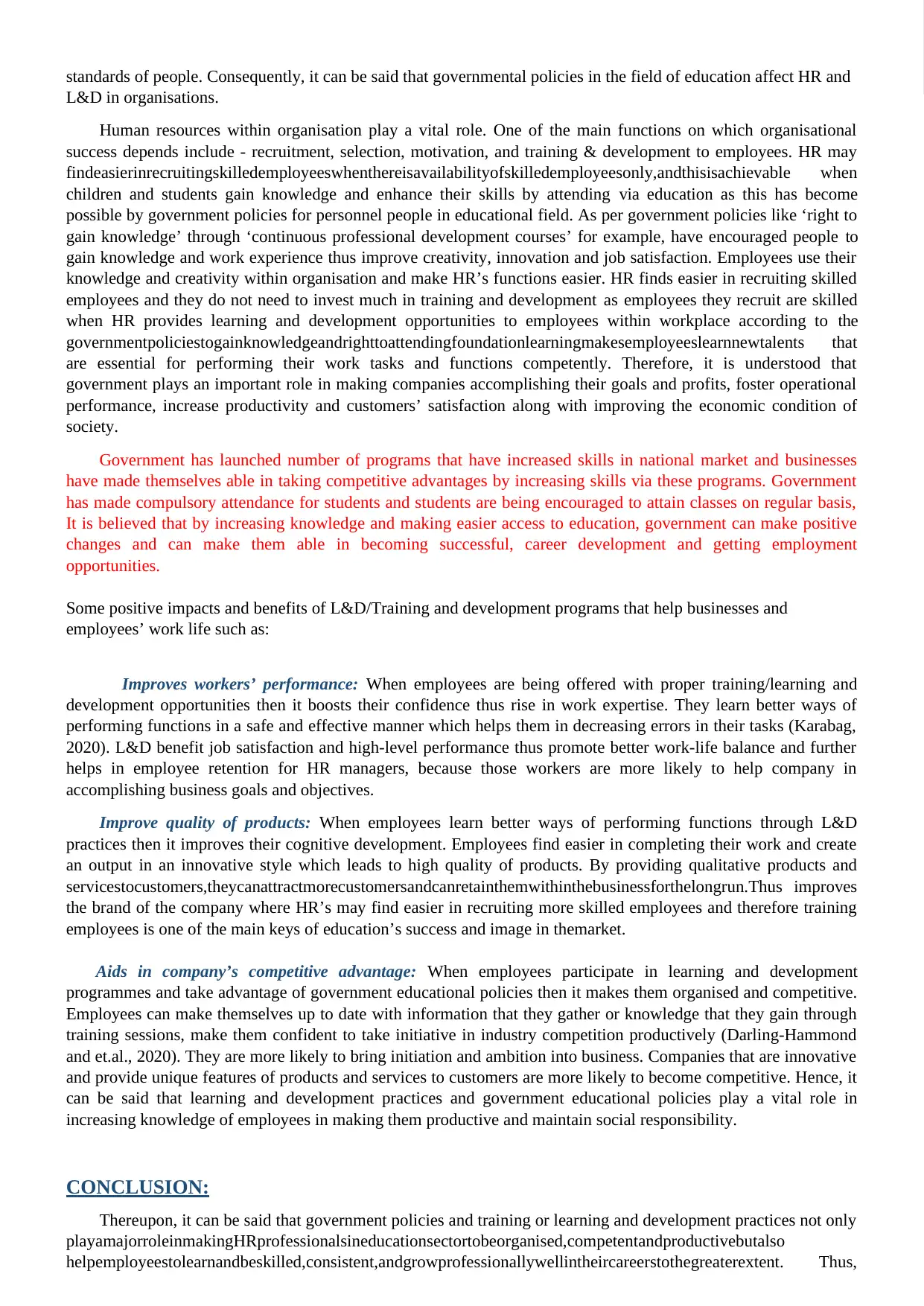
standards of people. Consequently, it can be said that governmental policies in the field of education affect HR and
L&D in organisations.
Human resources within organisation play a vital role. One of the main functions on which organisational
success depends include - recruitment, selection, motivation, and training & development to employees. HR may
findeasierinrecruitingskilledemployeeswhenthereisavailabilityofskilledemployeesonly,andthisisachievable when
children and students gain knowledge and enhance their skills by attending via education as this has become
possible by government policies for personnel people in educational field. As per government policies like ‘right to
gain knowledge’ through ‘continuous professional development courses’ for example, have encouraged people to
gain knowledge and work experience thus improve creativity, innovation and job satisfaction. Employees use their
knowledge and creativity within organisation and make HR’s functions easier. HR finds easier in recruiting skilled
employees and they do not need to invest much in training and development as employees they recruit are skilled
when HR provides learning and development opportunities to employees within workplace according to the
governmentpoliciestogainknowledgeandrighttoattendingfoundationlearningmakesemployeeslearnnewtalents that
are essential for performing their work tasks and functions competently. Therefore, it is understood that
government plays an important role in making companies accomplishing their goals and profits, foster operational
performance, increase productivity and customers’ satisfaction along with improving the economic condition of
society.
Government has launched number of programs that have increased skills in national market and businesses
have made themselves able in taking competitive advantages by increasing skills via these programs. Government
has made compulsory attendance for students and students are being encouraged to attain classes on regular basis,
It is believed that by increasing knowledge and making easier access to education, government can make positive
changes and can make them able in becoming successful, career development and getting employment
opportunities.
Some positive impacts and benefits of L&D/Training and development programs that help businesses and
employees’ work life such as:
Improves workers’ performance: When employees are being offered with proper training/learning and
development opportunities then it boosts their confidence thus rise in work expertise. They learn better ways of
performing functions in a safe and effective manner which helps them in decreasing errors in their tasks (Karabag,
2020). L&D benefit job satisfaction and high-level performance thus promote better work-life balance and further
helps in employee retention for HR managers, because those workers are more likely to help company in
accomplishing business goals and objectives.
Improve quality of products: When employees learn better ways of performing functions through L&D
practices then it improves their cognitive development. Employees find easier in completing their work and create
an output in an innovative style which leads to high quality of products. By providing qualitative products and
servicestocustomers,theycanattractmorecustomersandcanretainthemwithinthebusinessforthelongrun.Thus improves
the brand of the company where HR’s may find easier in recruiting more skilled employees and therefore training
employees is one of the main keys of education’s success and image in themarket.
Aids in company’s competitive advantage: When employees participate in learning and development
programmes and take advantage of government educational policies then it makes them organised and competitive.
Employees can make themselves up to date with information that they gather or knowledge that they gain through
training sessions, make them confident to take initiative in industry competition productively (Darling-Hammond
and et.al., 2020). They are more likely to bring initiation and ambition into business. Companies that are innovative
and provide unique features of products and services to customers are more likely to become competitive. Hence, it
can be said that learning and development practices and government educational policies play a vital role in
increasing knowledge of employees in making them productive and maintain social responsibility.
CONCLUSION:
Thereupon, it can be said that government policies and training or learning and development practices not only
playamajorroleinmakingHRprofessionalsineducationsectortobeorganised,competentandproductivebutalso
helpemployeestolearnandbeskilled,consistent,andgrowprofessionallywellintheircareerstothegreaterextent. Thus,
L&D in organisations.
Human resources within organisation play a vital role. One of the main functions on which organisational
success depends include - recruitment, selection, motivation, and training & development to employees. HR may
findeasierinrecruitingskilledemployeeswhenthereisavailabilityofskilledemployeesonly,andthisisachievable when
children and students gain knowledge and enhance their skills by attending via education as this has become
possible by government policies for personnel people in educational field. As per government policies like ‘right to
gain knowledge’ through ‘continuous professional development courses’ for example, have encouraged people to
gain knowledge and work experience thus improve creativity, innovation and job satisfaction. Employees use their
knowledge and creativity within organisation and make HR’s functions easier. HR finds easier in recruiting skilled
employees and they do not need to invest much in training and development as employees they recruit are skilled
when HR provides learning and development opportunities to employees within workplace according to the
governmentpoliciestogainknowledgeandrighttoattendingfoundationlearningmakesemployeeslearnnewtalents that
are essential for performing their work tasks and functions competently. Therefore, it is understood that
government plays an important role in making companies accomplishing their goals and profits, foster operational
performance, increase productivity and customers’ satisfaction along with improving the economic condition of
society.
Government has launched number of programs that have increased skills in national market and businesses
have made themselves able in taking competitive advantages by increasing skills via these programs. Government
has made compulsory attendance for students and students are being encouraged to attain classes on regular basis,
It is believed that by increasing knowledge and making easier access to education, government can make positive
changes and can make them able in becoming successful, career development and getting employment
opportunities.
Some positive impacts and benefits of L&D/Training and development programs that help businesses and
employees’ work life such as:
Improves workers’ performance: When employees are being offered with proper training/learning and
development opportunities then it boosts their confidence thus rise in work expertise. They learn better ways of
performing functions in a safe and effective manner which helps them in decreasing errors in their tasks (Karabag,
2020). L&D benefit job satisfaction and high-level performance thus promote better work-life balance and further
helps in employee retention for HR managers, because those workers are more likely to help company in
accomplishing business goals and objectives.
Improve quality of products: When employees learn better ways of performing functions through L&D
practices then it improves their cognitive development. Employees find easier in completing their work and create
an output in an innovative style which leads to high quality of products. By providing qualitative products and
servicestocustomers,theycanattractmorecustomersandcanretainthemwithinthebusinessforthelongrun.Thus improves
the brand of the company where HR’s may find easier in recruiting more skilled employees and therefore training
employees is one of the main keys of education’s success and image in themarket.
Aids in company’s competitive advantage: When employees participate in learning and development
programmes and take advantage of government educational policies then it makes them organised and competitive.
Employees can make themselves up to date with information that they gather or knowledge that they gain through
training sessions, make them confident to take initiative in industry competition productively (Darling-Hammond
and et.al., 2020). They are more likely to bring initiation and ambition into business. Companies that are innovative
and provide unique features of products and services to customers are more likely to become competitive. Hence, it
can be said that learning and development practices and government educational policies play a vital role in
increasing knowledge of employees in making them productive and maintain social responsibility.
CONCLUSION:
Thereupon, it can be said that government policies and training or learning and development practices not only
playamajorroleinmakingHRprofessionalsineducationsectortobeorganised,competentandproductivebutalso
helpemployeestolearnandbeskilled,consistent,andgrowprofessionallywellintheircareerstothegreaterextent. Thus,
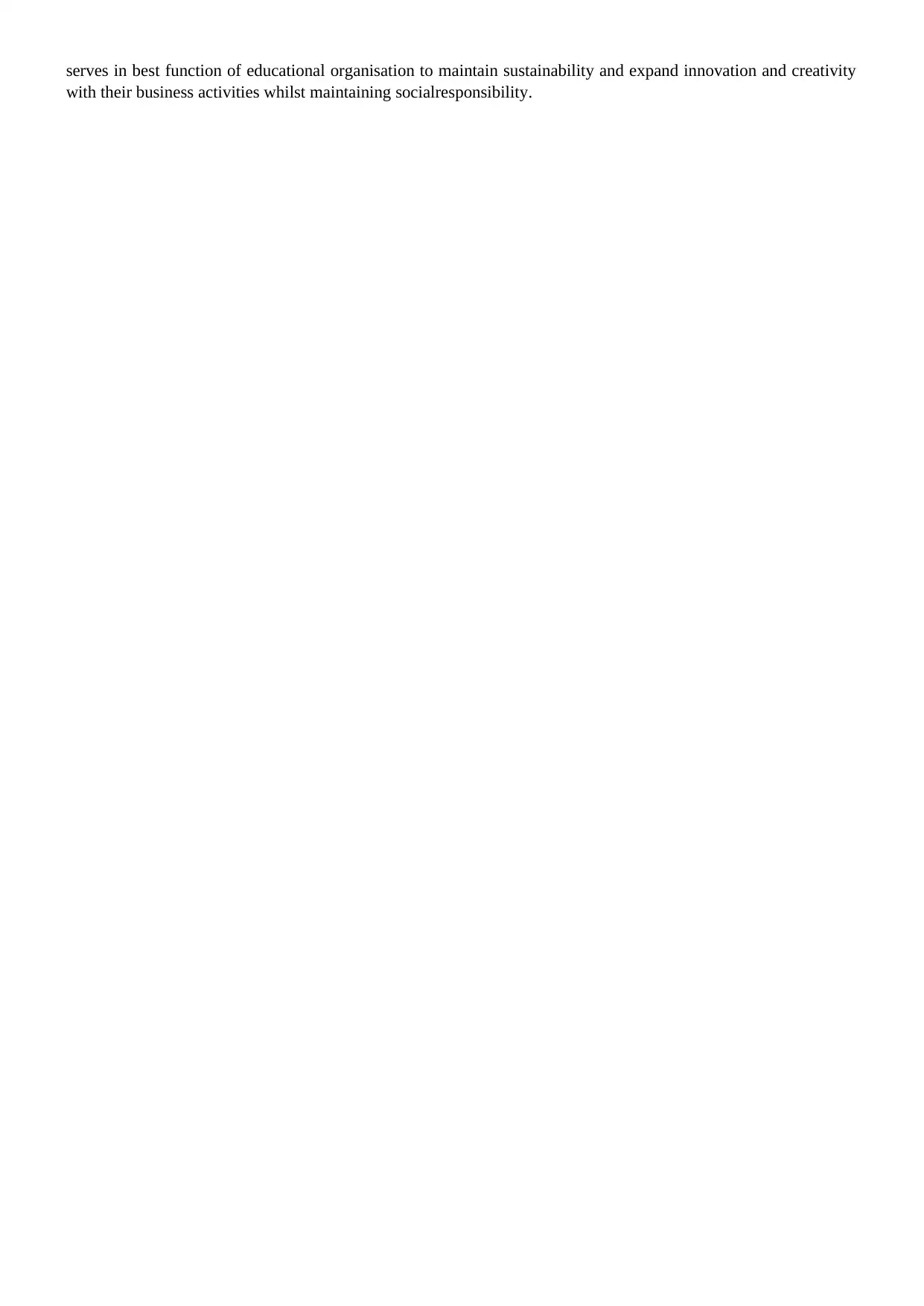
serves in best function of educational organisation to maintain sustainability and expand innovation and creativity
with their business activities whilst maintaining socialresponsibility.
with their business activities whilst maintaining socialresponsibility.
Secure Best Marks with AI Grader
Need help grading? Try our AI Grader for instant feedback on your assignments.
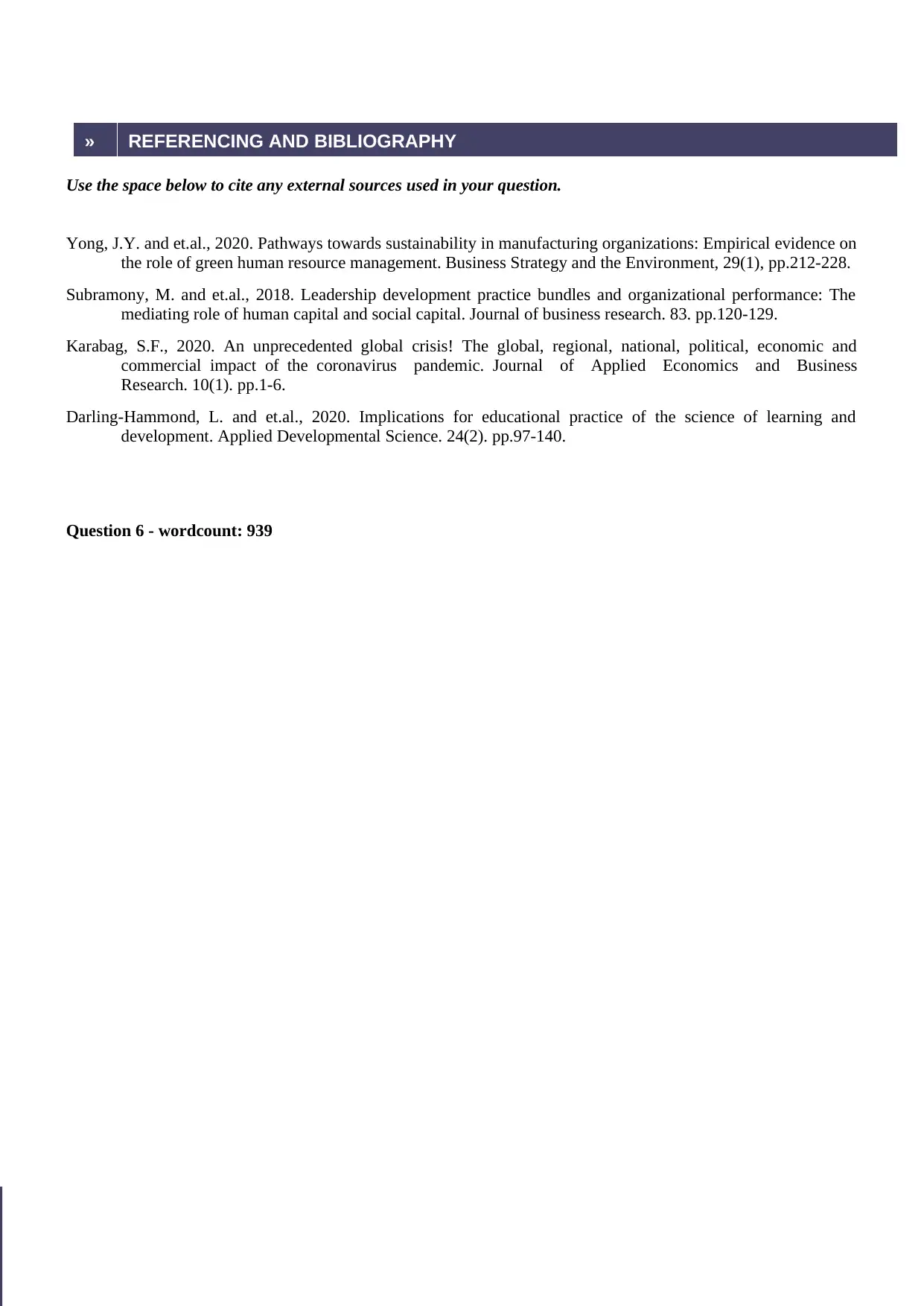
» REFERENCING AND BIBLIOGRAPHY
Use the space below to cite any external sources used in your question.
Yong, J.Y. and et.al., 2020. Pathways towards sustainability in manufacturing organizations: Empirical evidence on
the role of green human resource management. Business Strategy and the Environment, 29(1), pp.212-228.
Subramony, M. and et.al., 2018. Leadership development practice bundles and organizational performance: The
mediating role of human capital and social capital. Journal of business research. 83. pp.120-129.
Karabag, S.F., 2020. An unprecedented global crisis! The global, regional, national, political, economic and
commercial impact of the coronavirus pandemic. Journal of Applied Economics and Business
Research. 10(1). pp.1-6.
Darling-Hammond, L. and et.al., 2020. Implications for educational practice of the science of learning and
development. Applied Developmental Science. 24(2). pp.97-140.
Question 6 - wordcount: 939
Use the space below to cite any external sources used in your question.
Yong, J.Y. and et.al., 2020. Pathways towards sustainability in manufacturing organizations: Empirical evidence on
the role of green human resource management. Business Strategy and the Environment, 29(1), pp.212-228.
Subramony, M. and et.al., 2018. Leadership development practice bundles and organizational performance: The
mediating role of human capital and social capital. Journal of business research. 83. pp.120-129.
Karabag, S.F., 2020. An unprecedented global crisis! The global, regional, national, political, economic and
commercial impact of the coronavirus pandemic. Journal of Applied Economics and Business
Research. 10(1). pp.1-6.
Darling-Hammond, L. and et.al., 2020. Implications for educational practice of the science of learning and
development. Applied Developmental Science. 24(2). pp.97-140.
Question 6 - wordcount: 939
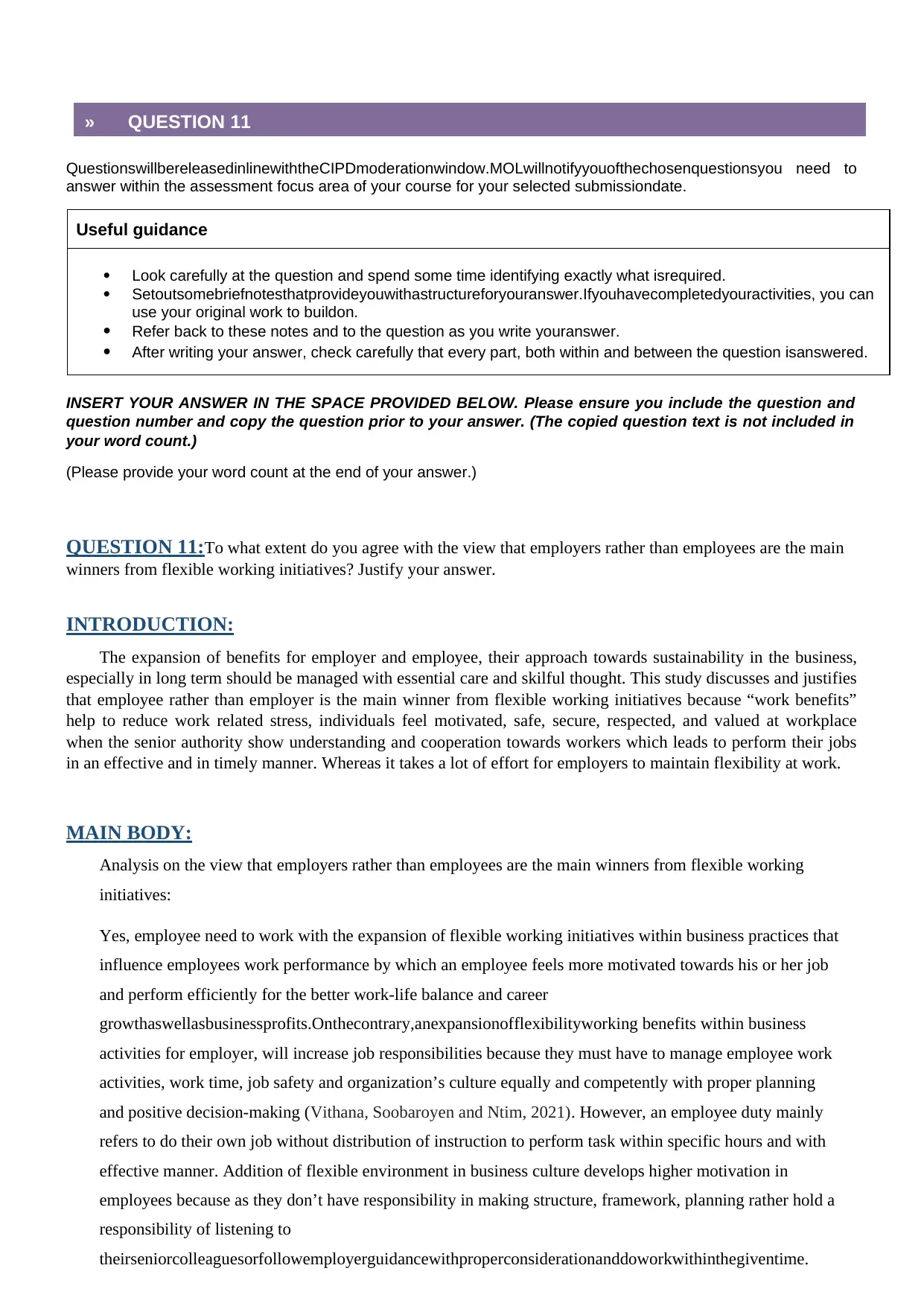
» QUESTION 11
QuestionswillbereleasedinlinewiththeCIPDmoderationwindow.MOLwillnotifyyouofthechosenquestionsyou need to
answer within the assessment focus area of your course for your selected submissiondate.
Useful guidance
Look carefully at the question and spend some time identifying exactly what isrequired.
Setoutsomebriefnotesthatprovideyouwithastructureforyouranswer.Ifyouhavecompletedyouractivities, you can
use your original work to buildon.
Refer back to these notes and to the question as you write youranswer.
After writing your answer, check carefully that every part, both within and between the question isanswered.
INSERT YOUR ANSWER IN THE SPACE PROVIDED BELOW. Please ensure you include the question and
question number and copy the question prior to your answer. (The copied question text is not included in
your word count.)
(Please provide your word count at the end of your answer.)
QUESTION 11:To what extent do you agree with the view that employers rather than employees are the main
winners from flexible working initiatives? Justify your answer.
INTRODUCTION:
The expansion of benefits for employer and employee, their approach towards sustainability in the business,
especially in long term should be managed with essential care and skilful thought. This study discusses and justifies
that employee rather than employer is the main winner from flexible working initiatives because “work benefits”
help to reduce work related stress, individuals feel motivated, safe, secure, respected, and valued at workplace
when the senior authority show understanding and cooperation towards workers which leads to perform their jobs
in an effective and in timely manner. Whereas it takes a lot of effort for employers to maintain flexibility at work.
MAIN BODY:
Analysis on the view that employers rather than employees are the main winners from flexible working
initiatives:
Yes, employee need to work with the expansion of flexible working initiatives within business practices that
influence employees work performance by which an employee feels more motivated towards his or her job
and perform efficiently for the better work-life balance and career
growthaswellasbusinessprofits.Onthecontrary,anexpansionofflexibilityworking benefits within business
activities for employer, will increase job responsibilities because they must have to manage employee work
activities, work time, job safety and organization’s culture equally and competently with proper planning
and positive decision-making (Vithana, Soobaroyen and Ntim, 2021). However, an employee duty mainly
refers to do their own job without distribution of instruction to perform task within specific hours and with
effective manner. Addition of flexible environment in business culture develops higher motivation in
employees because as they don’t have responsibility in making structure, framework, planning rather hold a
responsibility of listening to
theirseniorcolleaguesorfollowemployerguidancewithproperconsiderationanddoworkwithinthegiventime.
QuestionswillbereleasedinlinewiththeCIPDmoderationwindow.MOLwillnotifyyouofthechosenquestionsyou need to
answer within the assessment focus area of your course for your selected submissiondate.
Useful guidance
Look carefully at the question and spend some time identifying exactly what isrequired.
Setoutsomebriefnotesthatprovideyouwithastructureforyouranswer.Ifyouhavecompletedyouractivities, you can
use your original work to buildon.
Refer back to these notes and to the question as you write youranswer.
After writing your answer, check carefully that every part, both within and between the question isanswered.
INSERT YOUR ANSWER IN THE SPACE PROVIDED BELOW. Please ensure you include the question and
question number and copy the question prior to your answer. (The copied question text is not included in
your word count.)
(Please provide your word count at the end of your answer.)
QUESTION 11:To what extent do you agree with the view that employers rather than employees are the main
winners from flexible working initiatives? Justify your answer.
INTRODUCTION:
The expansion of benefits for employer and employee, their approach towards sustainability in the business,
especially in long term should be managed with essential care and skilful thought. This study discusses and justifies
that employee rather than employer is the main winner from flexible working initiatives because “work benefits”
help to reduce work related stress, individuals feel motivated, safe, secure, respected, and valued at workplace
when the senior authority show understanding and cooperation towards workers which leads to perform their jobs
in an effective and in timely manner. Whereas it takes a lot of effort for employers to maintain flexibility at work.
MAIN BODY:
Analysis on the view that employers rather than employees are the main winners from flexible working
initiatives:
Yes, employee need to work with the expansion of flexible working initiatives within business practices that
influence employees work performance by which an employee feels more motivated towards his or her job
and perform efficiently for the better work-life balance and career
growthaswellasbusinessprofits.Onthecontrary,anexpansionofflexibilityworking benefits within business
activities for employer, will increase job responsibilities because they must have to manage employee work
activities, work time, job safety and organization’s culture equally and competently with proper planning
and positive decision-making (Vithana, Soobaroyen and Ntim, 2021). However, an employee duty mainly
refers to do their own job without distribution of instruction to perform task within specific hours and with
effective manner. Addition of flexible environment in business culture develops higher motivation in
employees because as they don’t have responsibility in making structure, framework, planning rather hold a
responsibility of listening to
theirseniorcolleaguesorfollowemployerguidancewithproperconsiderationanddoworkwithinthegiventime.

Paraphrase This Document
Need a fresh take? Get an instant paraphrase of this document with our AI Paraphraser
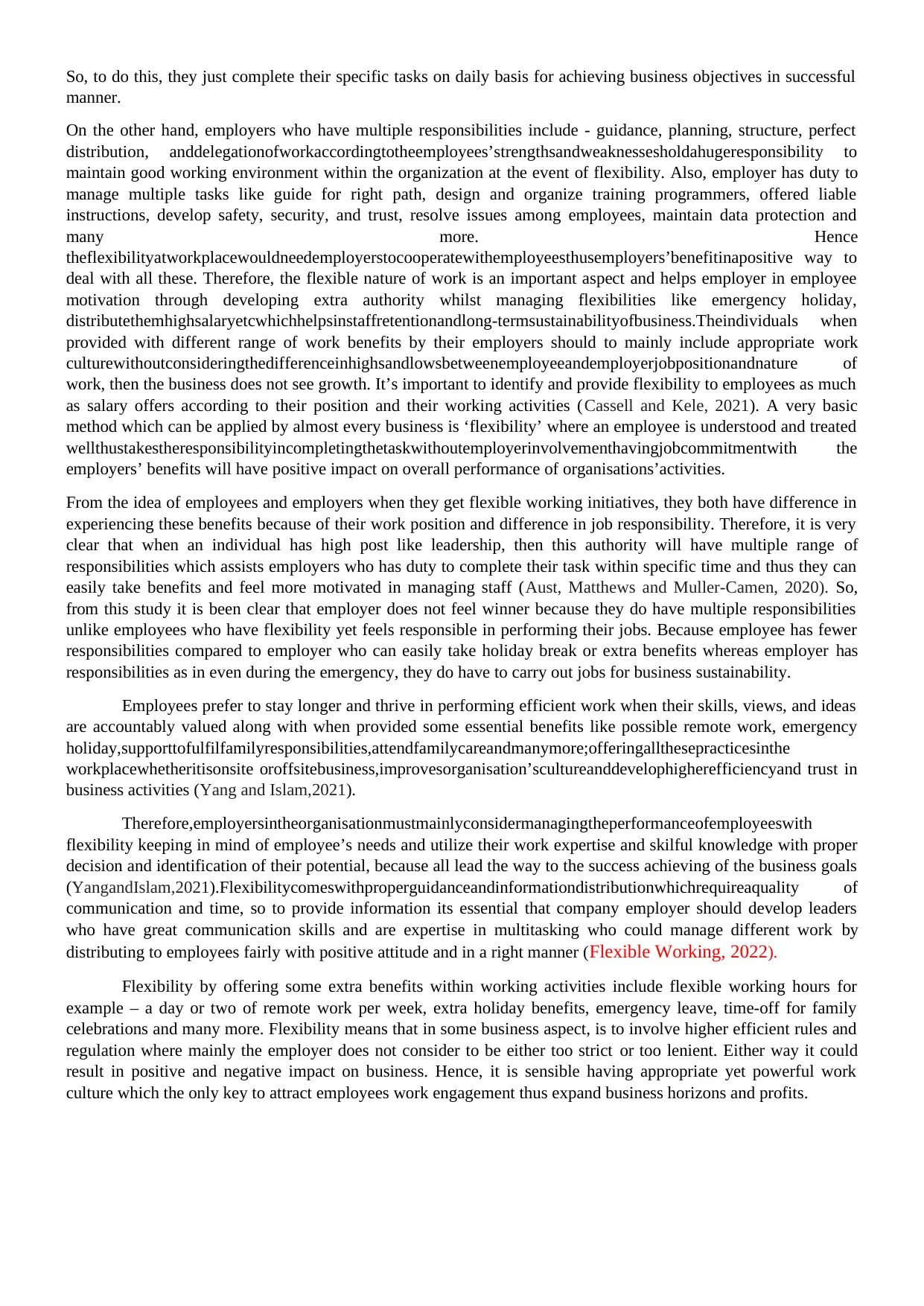
So, to do this, they just complete their specific tasks on daily basis for achieving business objectives in successful
manner.
On the other hand, employers who have multiple responsibilities include - guidance, planning, structure, perfect
distribution, anddelegationofworkaccordingtotheemployees’strengthsandweaknessesholdahugeresponsibility to
maintain good working environment within the organization at the event of flexibility. Also, employer has duty to
manage multiple tasks like guide for right path, design and organize training programmers, offered liable
instructions, develop safety, security, and trust, resolve issues among employees, maintain data protection and
many more. Hence
theflexibilityatworkplacewouldneedemployerstocooperatewithemployeesthusemployers’benefitinapositive way to
deal with all these. Therefore, the flexible nature of work is an important aspect and helps employer in employee
motivation through developing extra authority whilst managing flexibilities like emergency holiday,
distributethemhighsalaryetcwhichhelpsinstaffretentionandlong-termsustainabilityofbusiness.Theindividuals when
provided with different range of work benefits by their employers should to mainly include appropriate work
culturewithoutconsideringthedifferenceinhighsandlowsbetweenemployeeandemployerjobpositionandnature of
work, then the business does not see growth. It’s important to identify and provide flexibility to employees as much
as salary offers according to their position and their working activities (Cassell and Kele, 2021). A very basic
method which can be applied by almost every business is ‘flexibility’ where an employee is understood and treated
wellthustakestheresponsibilityincompletingthetaskwithoutemployerinvolvementhavingjobcommitmentwith the
employers’ benefits will have positive impact on overall performance of organisations’activities.
From the idea of employees and employers when they get flexible working initiatives, they both have difference in
experiencing these benefits because of their work position and difference in job responsibility. Therefore, it is very
clear that when an individual has high post like leadership, then this authority will have multiple range of
responsibilities which assists employers who has duty to complete their task within specific time and thus they can
easily take benefits and feel more motivated in managing staff (Aust, Matthews and Muller-Camen, 2020). So,
from this study it is been clear that employer does not feel winner because they do have multiple responsibilities
unlike employees who have flexibility yet feels responsible in performing their jobs. Because employee has fewer
responsibilities compared to employer who can easily take holiday break or extra benefits whereas employer has
responsibilities as in even during the emergency, they do have to carry out jobs for business sustainability.
Employees prefer to stay longer and thrive in performing efficient work when their skills, views, and ideas
are accountably valued along with when provided some essential benefits like possible remote work, emergency
holiday,supporttofulfilfamilyresponsibilities,attendfamilycareandmanymore;offeringallthesepracticesinthe
workplacewhetheritisonsite oroffsitebusiness,improvesorganisation’scultureanddevelophigherefficiencyand trust in
business activities (Yang and Islam,2021).
Therefore,employersintheorganisationmustmainlyconsidermanagingtheperformanceofemployeeswith
flexibility keeping in mind of employee’s needs and utilize their work expertise and skilful knowledge with proper
decision and identification of their potential, because all lead the way to the success achieving of the business goals
(YangandIslam,2021).Flexibilitycomeswithproperguidanceandinformationdistributionwhichrequireaquality of
communication and time, so to provide information its essential that company employer should develop leaders
who have great communication skills and are expertise in multitasking who could manage different work by
distributing to employees fairly with positive attitude and in a right manner (Flexible Working, 2022).
Flexibility by offering some extra benefits within working activities include flexible working hours for
example – a day or two of remote work per week, extra holiday benefits, emergency leave, time-off for family
celebrations and many more. Flexibility means that in some business aspect, is to involve higher efficient rules and
regulation where mainly the employer does not consider to be either too strict or too lenient. Either way it could
result in positive and negative impact on business. Hence, it is sensible having appropriate yet powerful work
culture which the only key to attract employees work engagement thus expand business horizons and profits.
manner.
On the other hand, employers who have multiple responsibilities include - guidance, planning, structure, perfect
distribution, anddelegationofworkaccordingtotheemployees’strengthsandweaknessesholdahugeresponsibility to
maintain good working environment within the organization at the event of flexibility. Also, employer has duty to
manage multiple tasks like guide for right path, design and organize training programmers, offered liable
instructions, develop safety, security, and trust, resolve issues among employees, maintain data protection and
many more. Hence
theflexibilityatworkplacewouldneedemployerstocooperatewithemployeesthusemployers’benefitinapositive way to
deal with all these. Therefore, the flexible nature of work is an important aspect and helps employer in employee
motivation through developing extra authority whilst managing flexibilities like emergency holiday,
distributethemhighsalaryetcwhichhelpsinstaffretentionandlong-termsustainabilityofbusiness.Theindividuals when
provided with different range of work benefits by their employers should to mainly include appropriate work
culturewithoutconsideringthedifferenceinhighsandlowsbetweenemployeeandemployerjobpositionandnature of
work, then the business does not see growth. It’s important to identify and provide flexibility to employees as much
as salary offers according to their position and their working activities (Cassell and Kele, 2021). A very basic
method which can be applied by almost every business is ‘flexibility’ where an employee is understood and treated
wellthustakestheresponsibilityincompletingthetaskwithoutemployerinvolvementhavingjobcommitmentwith the
employers’ benefits will have positive impact on overall performance of organisations’activities.
From the idea of employees and employers when they get flexible working initiatives, they both have difference in
experiencing these benefits because of their work position and difference in job responsibility. Therefore, it is very
clear that when an individual has high post like leadership, then this authority will have multiple range of
responsibilities which assists employers who has duty to complete their task within specific time and thus they can
easily take benefits and feel more motivated in managing staff (Aust, Matthews and Muller-Camen, 2020). So,
from this study it is been clear that employer does not feel winner because they do have multiple responsibilities
unlike employees who have flexibility yet feels responsible in performing their jobs. Because employee has fewer
responsibilities compared to employer who can easily take holiday break or extra benefits whereas employer has
responsibilities as in even during the emergency, they do have to carry out jobs for business sustainability.
Employees prefer to stay longer and thrive in performing efficient work when their skills, views, and ideas
are accountably valued along with when provided some essential benefits like possible remote work, emergency
holiday,supporttofulfilfamilyresponsibilities,attendfamilycareandmanymore;offeringallthesepracticesinthe
workplacewhetheritisonsite oroffsitebusiness,improvesorganisation’scultureanddevelophigherefficiencyand trust in
business activities (Yang and Islam,2021).
Therefore,employersintheorganisationmustmainlyconsidermanagingtheperformanceofemployeeswith
flexibility keeping in mind of employee’s needs and utilize their work expertise and skilful knowledge with proper
decision and identification of their potential, because all lead the way to the success achieving of the business goals
(YangandIslam,2021).Flexibilitycomeswithproperguidanceandinformationdistributionwhichrequireaquality of
communication and time, so to provide information its essential that company employer should develop leaders
who have great communication skills and are expertise in multitasking who could manage different work by
distributing to employees fairly with positive attitude and in a right manner (Flexible Working, 2022).
Flexibility by offering some extra benefits within working activities include flexible working hours for
example – a day or two of remote work per week, extra holiday benefits, emergency leave, time-off for family
celebrations and many more. Flexibility means that in some business aspect, is to involve higher efficient rules and
regulation where mainly the employer does not consider to be either too strict or too lenient. Either way it could
result in positive and negative impact on business. Hence, it is sensible having appropriate yet powerful work
culture which the only key to attract employees work engagement thus expand business horizons and profits.
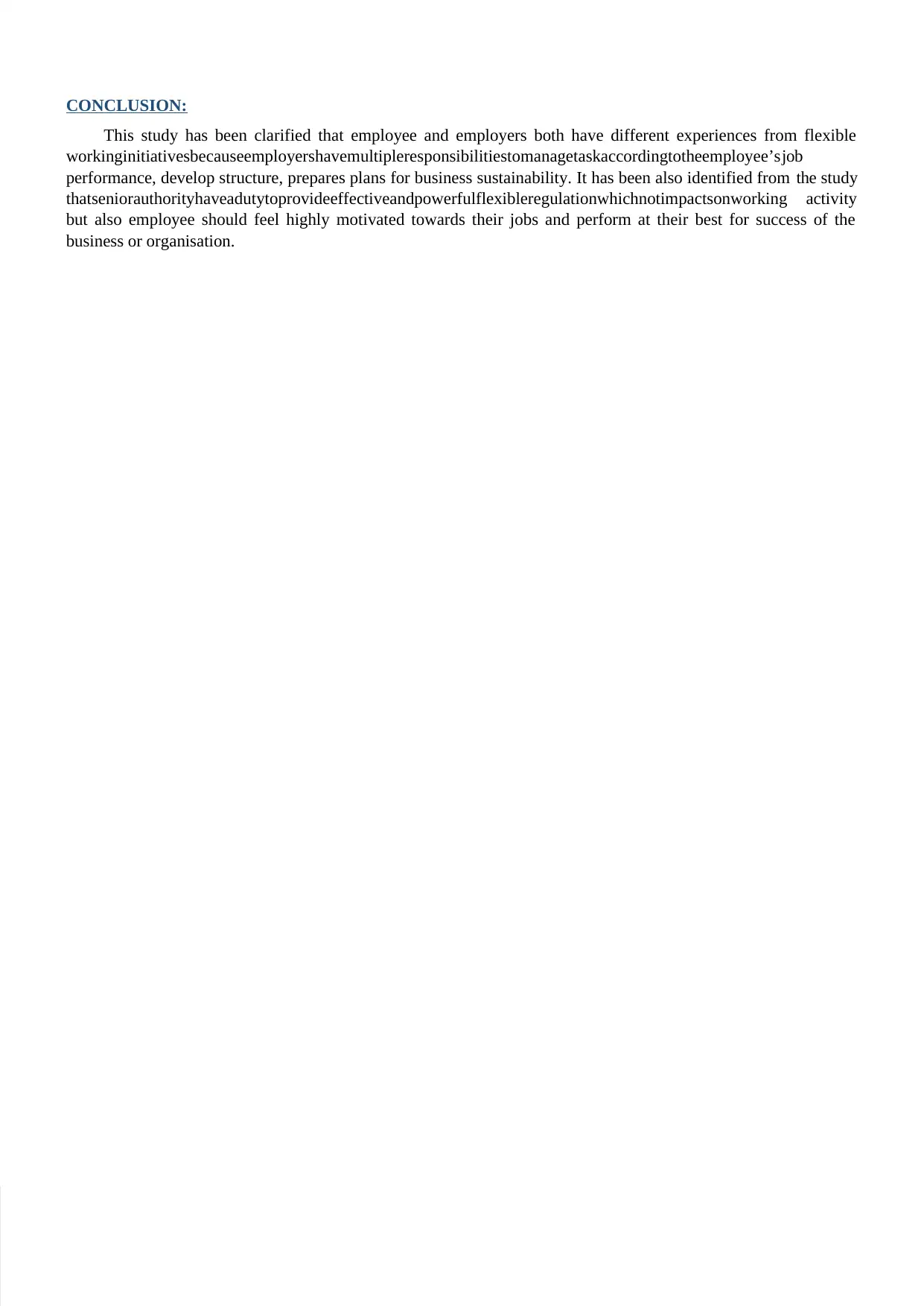
CONCLUSION:
This study has been clarified that employee and employers both have different experiences from flexible
workinginitiativesbecauseemployershavemultipleresponsibilitiestomanagetaskaccordingtotheemployee’sjob
performance, develop structure, prepares plans for business sustainability. It has been also identified from the study
thatseniorauthorityhaveadutytoprovideeffectiveandpowerfulflexibleregulationwhichnotimpactsonworking activity
but also employee should feel highly motivated towards their jobs and perform at their best for success of the
business or organisation.
This study has been clarified that employee and employers both have different experiences from flexible
workinginitiativesbecauseemployershavemultipleresponsibilitiestomanagetaskaccordingtotheemployee’sjob
performance, develop structure, prepares plans for business sustainability. It has been also identified from the study
thatseniorauthorityhaveadutytoprovideeffectiveandpowerfulflexibleregulationwhichnotimpactsonworking activity
but also employee should feel highly motivated towards their jobs and perform at their best for success of the
business or organisation.
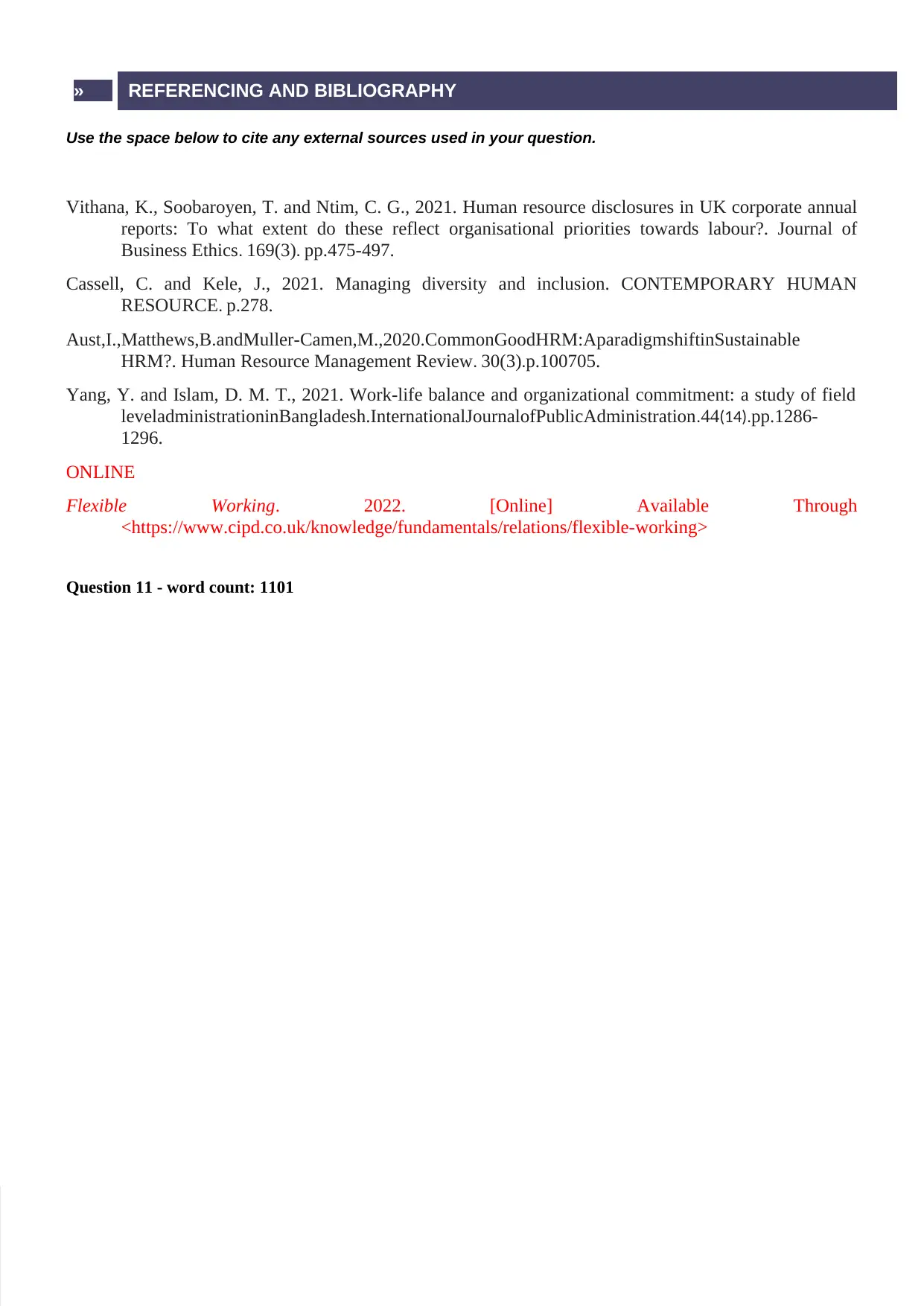
» REFERENCING AND BIBLIOGRAPHY
Use the space below to cite any external sources used in your question.
Vithana, K., Soobaroyen, T. and Ntim, C. G., 2021. Human resource disclosures in UK corporate annual
reports: To what extent do these reflect organisational priorities towards labour?. Journal of
Business Ethics. 169(3). pp.475-497.
Cassell, C. and Kele, J., 2021. Managing diversity and inclusion. CONTEMPORARY HUMAN
RESOURCE. p.278.
Aust,I.,Matthews,B.andMuller-Camen,M.,2020.CommonGoodHRM:AparadigmshiftinSustainable
HRM?. Human Resource Management Review. 30(3).p.100705.
Yang, Y. and Islam, D. M. T., 2021. Work-life balance and organizational commitment: a study of field
leveladministrationinBangladesh.InternationalJournalofPublicAdministration.44(14).pp.1286-
1296.
ONLINE
Flexible Working. 2022. [Online] Available Through
<https://www.cipd.co.uk/knowledge/fundamentals/relations/flexible-working>
Question 11 - word count: 1101
Use the space below to cite any external sources used in your question.
Vithana, K., Soobaroyen, T. and Ntim, C. G., 2021. Human resource disclosures in UK corporate annual
reports: To what extent do these reflect organisational priorities towards labour?. Journal of
Business Ethics. 169(3). pp.475-497.
Cassell, C. and Kele, J., 2021. Managing diversity and inclusion. CONTEMPORARY HUMAN
RESOURCE. p.278.
Aust,I.,Matthews,B.andMuller-Camen,M.,2020.CommonGoodHRM:AparadigmshiftinSustainable
HRM?. Human Resource Management Review. 30(3).p.100705.
Yang, Y. and Islam, D. M. T., 2021. Work-life balance and organizational commitment: a study of field
leveladministrationinBangladesh.InternationalJournalofPublicAdministration.44(14).pp.1286-
1296.
ONLINE
Flexible Working. 2022. [Online] Available Through
<https://www.cipd.co.uk/knowledge/fundamentals/relations/flexible-working>
Question 11 - word count: 1101
Secure Best Marks with AI Grader
Need help grading? Try our AI Grader for instant feedback on your assignments.
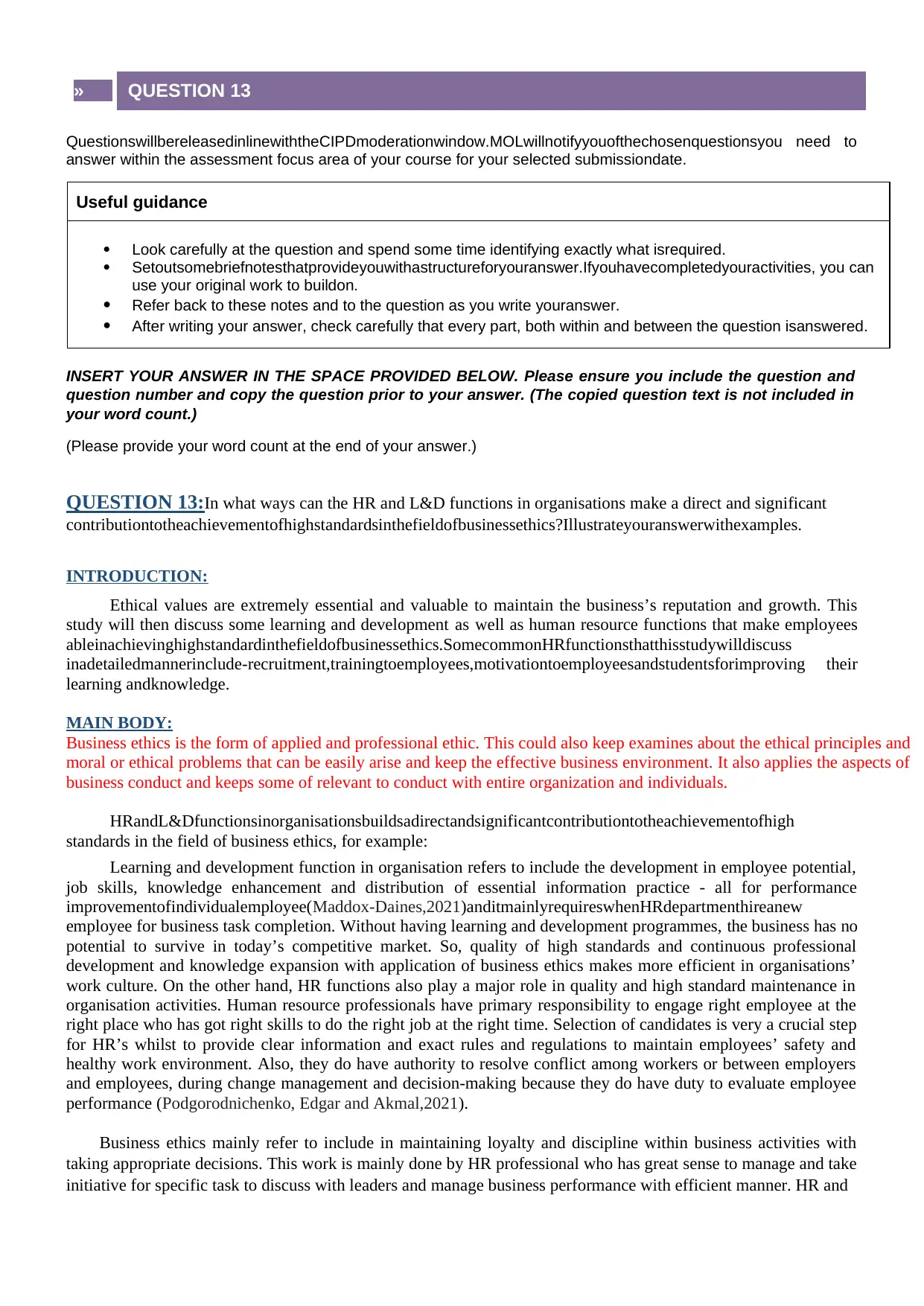
» QUESTION 13
QuestionswillbereleasedinlinewiththeCIPDmoderationwindow.MOLwillnotifyyouofthechosenquestionsyou need to
answer within the assessment focus area of your course for your selected submissiondate.
Useful guidance
Look carefully at the question and spend some time identifying exactly what isrequired.
Setoutsomebriefnotesthatprovideyouwithastructureforyouranswer.Ifyouhavecompletedyouractivities, you can
use your original work to buildon.
Refer back to these notes and to the question as you write youranswer.
After writing your answer, check carefully that every part, both within and between the question isanswered.
INSERT YOUR ANSWER IN THE SPACE PROVIDED BELOW. Please ensure you include the question and
question number and copy the question prior to your answer. (The copied question text is not included in
your word count.)
(Please provide your word count at the end of your answer.)
QUESTION 13:In what ways can the HR and L&D functions in organisations make a direct and significant
contributiontotheachievementofhighstandardsinthefieldofbusinessethics?Illustrateyouranswerwithexamples.
INTRODUCTION:
Ethical values are extremely essential and valuable to maintain the business’s reputation and growth. This
study will then discuss some learning and development as well as human resource functions that make employees
ableinachievinghighstandardinthefieldofbusinessethics.SomecommonHRfunctionsthatthisstudywilldiscuss
inadetailedmannerinclude-recruitment,trainingtoemployees,motivationtoemployeesandstudentsforimproving their
learning andknowledge.
MAIN BODY:
Business ethics is the form of applied and professional ethic. This could also keep examines about the ethical principles and
moral or ethical problems that can be easily arise and keep the effective business environment. It also applies the aspects of
business conduct and keeps some of relevant to conduct with entire organization and individuals.
HRandL&Dfunctionsinorganisationsbuildsadirectandsignificantcontributiontotheachievementofhigh
standards in the field of business ethics, for example:
Learning and development function in organisation refers to include the development in employee potential,
job skills, knowledge enhancement and distribution of essential information practice - all for performance
improvementofindividualemployee(Maddox-Daines,2021)anditmainlyrequireswhenHRdepartmenthireanew
employee for business task completion. Without having learning and development programmes, the business has no
potential to survive in today’s competitive market. So, quality of high standards and continuous professional
development and knowledge expansion with application of business ethics makes more efficient in organisations’
work culture. On the other hand, HR functions also play a major role in quality and high standard maintenance in
organisation activities. Human resource professionals have primary responsibility to engage right employee at the
right place who has got right skills to do the right job at the right time. Selection of candidates is very a crucial step
for HR’s whilst to provide clear information and exact rules and regulations to maintain employees’ safety and
healthy work environment. Also, they do have authority to resolve conflict among workers or between employers
and employees, during change management and decision-making because they do have duty to evaluate employee
performance (Podgorodnichenko, Edgar and Akmal,2021).
Business ethics mainly refer to include in maintaining loyalty and discipline within business activities with
taking appropriate decisions. This work is mainly done by HR professional who has great sense to manage and take
initiative for specific task to discuss with leaders and manage business performance with efficient manner. HR and
QuestionswillbereleasedinlinewiththeCIPDmoderationwindow.MOLwillnotifyyouofthechosenquestionsyou need to
answer within the assessment focus area of your course for your selected submissiondate.
Useful guidance
Look carefully at the question and spend some time identifying exactly what isrequired.
Setoutsomebriefnotesthatprovideyouwithastructureforyouranswer.Ifyouhavecompletedyouractivities, you can
use your original work to buildon.
Refer back to these notes and to the question as you write youranswer.
After writing your answer, check carefully that every part, both within and between the question isanswered.
INSERT YOUR ANSWER IN THE SPACE PROVIDED BELOW. Please ensure you include the question and
question number and copy the question prior to your answer. (The copied question text is not included in
your word count.)
(Please provide your word count at the end of your answer.)
QUESTION 13:In what ways can the HR and L&D functions in organisations make a direct and significant
contributiontotheachievementofhighstandardsinthefieldofbusinessethics?Illustrateyouranswerwithexamples.
INTRODUCTION:
Ethical values are extremely essential and valuable to maintain the business’s reputation and growth. This
study will then discuss some learning and development as well as human resource functions that make employees
ableinachievinghighstandardinthefieldofbusinessethics.SomecommonHRfunctionsthatthisstudywilldiscuss
inadetailedmannerinclude-recruitment,trainingtoemployees,motivationtoemployeesandstudentsforimproving their
learning andknowledge.
MAIN BODY:
Business ethics is the form of applied and professional ethic. This could also keep examines about the ethical principles and
moral or ethical problems that can be easily arise and keep the effective business environment. It also applies the aspects of
business conduct and keeps some of relevant to conduct with entire organization and individuals.
HRandL&Dfunctionsinorganisationsbuildsadirectandsignificantcontributiontotheachievementofhigh
standards in the field of business ethics, for example:
Learning and development function in organisation refers to include the development in employee potential,
job skills, knowledge enhancement and distribution of essential information practice - all for performance
improvementofindividualemployee(Maddox-Daines,2021)anditmainlyrequireswhenHRdepartmenthireanew
employee for business task completion. Without having learning and development programmes, the business has no
potential to survive in today’s competitive market. So, quality of high standards and continuous professional
development and knowledge expansion with application of business ethics makes more efficient in organisations’
work culture. On the other hand, HR functions also play a major role in quality and high standard maintenance in
organisation activities. Human resource professionals have primary responsibility to engage right employee at the
right place who has got right skills to do the right job at the right time. Selection of candidates is very a crucial step
for HR’s whilst to provide clear information and exact rules and regulations to maintain employees’ safety and
healthy work environment. Also, they do have authority to resolve conflict among workers or between employers
and employees, during change management and decision-making because they do have duty to evaluate employee
performance (Podgorodnichenko, Edgar and Akmal,2021).
Business ethics mainly refer to include in maintaining loyalty and discipline within business activities with
taking appropriate decisions. This work is mainly done by HR professional who has great sense to manage and take
initiative for specific task to discuss with leaders and manage business performance with efficient manner. HR and
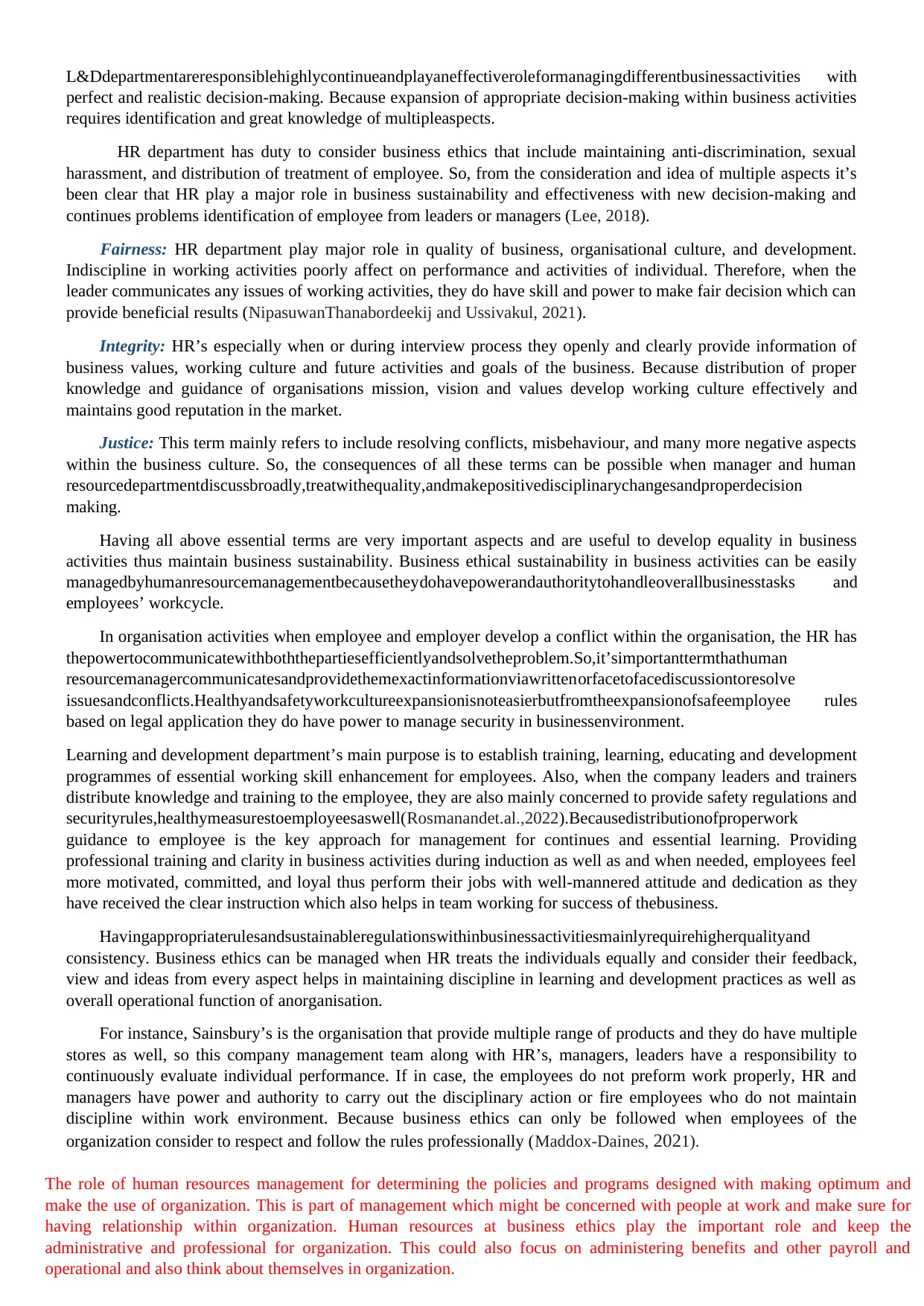
L&Ddepartmentareresponsiblehighlycontinueandplayaneffectiveroleformanagingdifferentbusinessactivities with
perfect and realistic decision-making. Because expansion of appropriate decision-making within business activities
requires identification and great knowledge of multipleaspects.
HR department has duty to consider business ethics that include maintaining anti-discrimination, sexual
harassment, and distribution of treatment of employee. So, from the consideration and idea of multiple aspects it’s
been clear that HR play a major role in business sustainability and effectiveness with new decision-making and
continues problems identification of employee from leaders or managers (Lee, 2018).
Fairness: HR department play major role in quality of business, organisational culture, and development.
Indiscipline in working activities poorly affect on performance and activities of individual. Therefore, when the
leader communicates any issues of working activities, they do have skill and power to make fair decision which can
provide beneficial results (NipasuwanThanabordeekij and Ussivakul, 2021).
Integrity: HR’s especially when or during interview process they openly and clearly provide information of
business values, working culture and future activities and goals of the business. Because distribution of proper
knowledge and guidance of organisations mission, vision and values develop working culture effectively and
maintains good reputation in the market.
Justice: This term mainly refers to include resolving conflicts, misbehaviour, and many more negative aspects
within the business culture. So, the consequences of all these terms can be possible when manager and human
resourcedepartmentdiscussbroadly,treatwithequality,andmakepositivedisciplinarychangesandproperdecision
making.
Having all above essential terms are very important aspects and are useful to develop equality in business
activities thus maintain business sustainability. Business ethical sustainability in business activities can be easily
managedbyhumanresourcemanagementbecausetheydohavepowerandauthoritytohandleoverallbusinesstasks and
employees’ workcycle.
In organisation activities when employee and employer develop a conflict within the organisation, the HR has
thepowertocommunicatewithboththepartiesefficientlyandsolvetheproblem.So,it’simportanttermthathuman
resourcemanagercommunicatesandprovidethemexactinformationviawrittenorfacetofacediscussiontoresolve
issuesandconflicts.Healthyandsafetyworkcultureexpansionisnoteasierbutfromtheexpansionofsafeemployee rules
based on legal application they do have power to manage security in businessenvironment.
Learning and development department’s main purpose is to establish training, learning, educating and development
programmes of essential working skill enhancement for employees. Also, when the company leaders and trainers
distribute knowledge and training to the employee, they are also mainly concerned to provide safety regulations and
securityrules,healthymeasurestoemployeesaswell(Rosmanandet.al.,2022).Becausedistributionofproperwork
guidance to employee is the key approach for management for continues and essential learning. Providing
professional training and clarity in business activities during induction as well as and when needed, employees feel
more motivated, committed, and loyal thus perform their jobs with well-mannered attitude and dedication as they
have received the clear instruction which also helps in team working for success of thebusiness.
Havingappropriaterulesandsustainableregulationswithinbusinessactivitiesmainlyrequirehigherqualityand
consistency. Business ethics can be managed when HR treats the individuals equally and consider their feedback,
view and ideas from every aspect helps in maintaining discipline in learning and development practices as well as
overall operational function of anorganisation.
For instance, Sainsbury’s is the organisation that provide multiple range of products and they do have multiple
stores as well, so this company management team along with HR’s, managers, leaders have a responsibility to
continuously evaluate individual performance. If in case, the employees do not preform work properly, HR and
managers have power and authority to carry out the disciplinary action or fire employees who do not maintain
discipline within work environment. Because business ethics can only be followed when employees of the
organization consider to respect and follow the rules professionally (Maddox-Daines, 2021).
The role of human resources management for determining the policies and programs designed with making optimum and
make the use of organization. This is part of management which might be concerned with people at work and make sure for
having relationship within organization. Human resources at business ethics play the important role and keep the
administrative and professional for organization. This could also focus on administering benefits and other payroll and
operational and also think about themselves in organization.
perfect and realistic decision-making. Because expansion of appropriate decision-making within business activities
requires identification and great knowledge of multipleaspects.
HR department has duty to consider business ethics that include maintaining anti-discrimination, sexual
harassment, and distribution of treatment of employee. So, from the consideration and idea of multiple aspects it’s
been clear that HR play a major role in business sustainability and effectiveness with new decision-making and
continues problems identification of employee from leaders or managers (Lee, 2018).
Fairness: HR department play major role in quality of business, organisational culture, and development.
Indiscipline in working activities poorly affect on performance and activities of individual. Therefore, when the
leader communicates any issues of working activities, they do have skill and power to make fair decision which can
provide beneficial results (NipasuwanThanabordeekij and Ussivakul, 2021).
Integrity: HR’s especially when or during interview process they openly and clearly provide information of
business values, working culture and future activities and goals of the business. Because distribution of proper
knowledge and guidance of organisations mission, vision and values develop working culture effectively and
maintains good reputation in the market.
Justice: This term mainly refers to include resolving conflicts, misbehaviour, and many more negative aspects
within the business culture. So, the consequences of all these terms can be possible when manager and human
resourcedepartmentdiscussbroadly,treatwithequality,andmakepositivedisciplinarychangesandproperdecision
making.
Having all above essential terms are very important aspects and are useful to develop equality in business
activities thus maintain business sustainability. Business ethical sustainability in business activities can be easily
managedbyhumanresourcemanagementbecausetheydohavepowerandauthoritytohandleoverallbusinesstasks and
employees’ workcycle.
In organisation activities when employee and employer develop a conflict within the organisation, the HR has
thepowertocommunicatewithboththepartiesefficientlyandsolvetheproblem.So,it’simportanttermthathuman
resourcemanagercommunicatesandprovidethemexactinformationviawrittenorfacetofacediscussiontoresolve
issuesandconflicts.Healthyandsafetyworkcultureexpansionisnoteasierbutfromtheexpansionofsafeemployee rules
based on legal application they do have power to manage security in businessenvironment.
Learning and development department’s main purpose is to establish training, learning, educating and development
programmes of essential working skill enhancement for employees. Also, when the company leaders and trainers
distribute knowledge and training to the employee, they are also mainly concerned to provide safety regulations and
securityrules,healthymeasurestoemployeesaswell(Rosmanandet.al.,2022).Becausedistributionofproperwork
guidance to employee is the key approach for management for continues and essential learning. Providing
professional training and clarity in business activities during induction as well as and when needed, employees feel
more motivated, committed, and loyal thus perform their jobs with well-mannered attitude and dedication as they
have received the clear instruction which also helps in team working for success of thebusiness.
Havingappropriaterulesandsustainableregulationswithinbusinessactivitiesmainlyrequirehigherqualityand
consistency. Business ethics can be managed when HR treats the individuals equally and consider their feedback,
view and ideas from every aspect helps in maintaining discipline in learning and development practices as well as
overall operational function of anorganisation.
For instance, Sainsbury’s is the organisation that provide multiple range of products and they do have multiple
stores as well, so this company management team along with HR’s, managers, leaders have a responsibility to
continuously evaluate individual performance. If in case, the employees do not preform work properly, HR and
managers have power and authority to carry out the disciplinary action or fire employees who do not maintain
discipline within work environment. Because business ethics can only be followed when employees of the
organization consider to respect and follow the rules professionally (Maddox-Daines, 2021).
The role of human resources management for determining the policies and programs designed with making optimum and
make the use of organization. This is part of management which might be concerned with people at work and make sure for
having relationship within organization. Human resources at business ethics play the important role and keep the
administrative and professional for organization. This could also focus on administering benefits and other payroll and
operational and also think about themselves in organization.
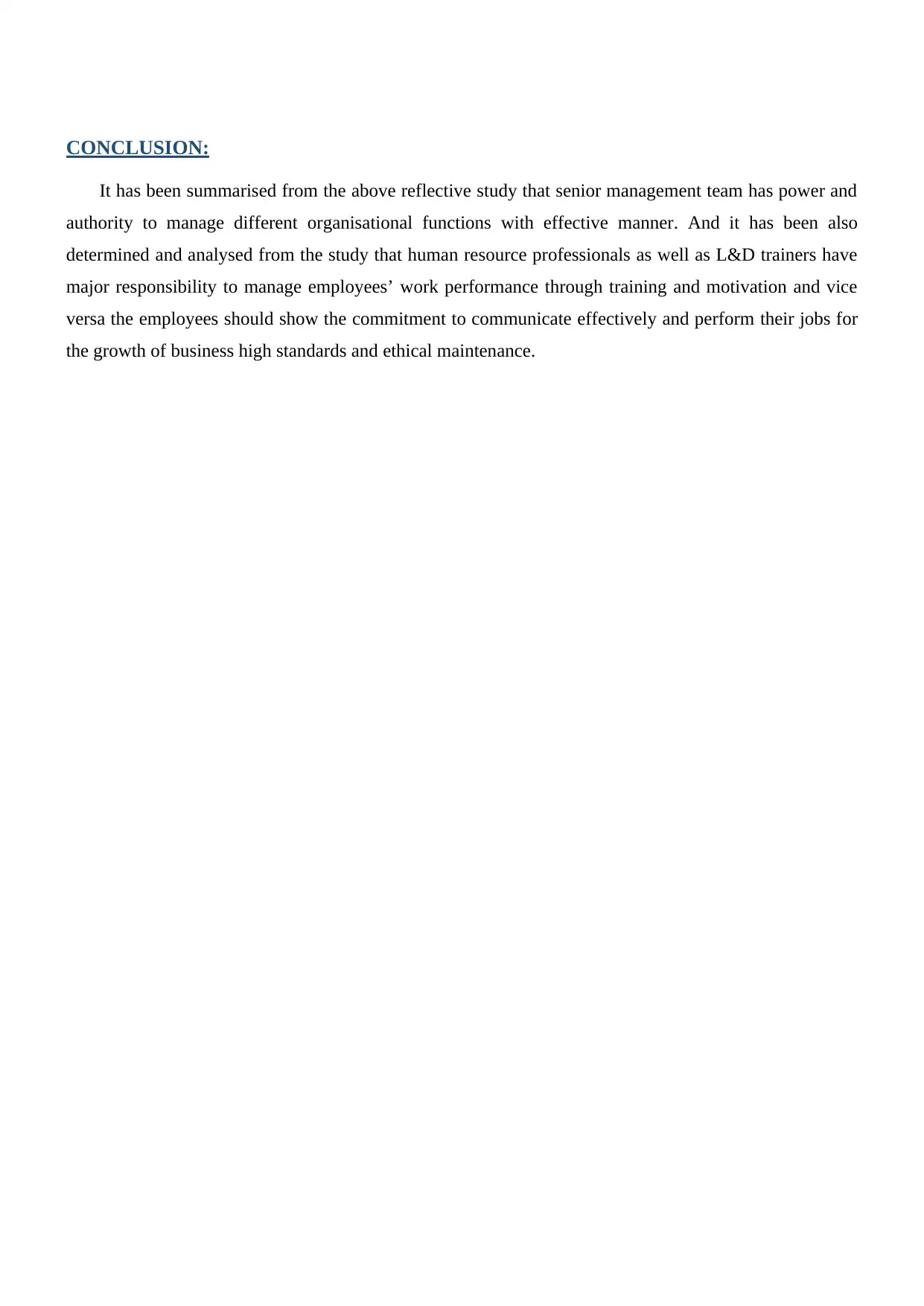
CONCLUSION:
It has been summarised from the above reflective study that senior management team has power and
authority to manage different organisational functions with effective manner. And it has been also
determined and analysed from the study that human resource professionals as well as L&D trainers have
major responsibility to manage employees’ work performance through training and motivation and vice
versa the employees should show the commitment to communicate effectively and perform their jobs for
the growth of business high standards and ethical maintenance.
It has been summarised from the above reflective study that senior management team has power and
authority to manage different organisational functions with effective manner. And it has been also
determined and analysed from the study that human resource professionals as well as L&D trainers have
major responsibility to manage employees’ work performance through training and motivation and vice
versa the employees should show the commitment to communicate effectively and perform their jobs for
the growth of business high standards and ethical maintenance.
Paraphrase This Document
Need a fresh take? Get an instant paraphrase of this document with our AI Paraphraser
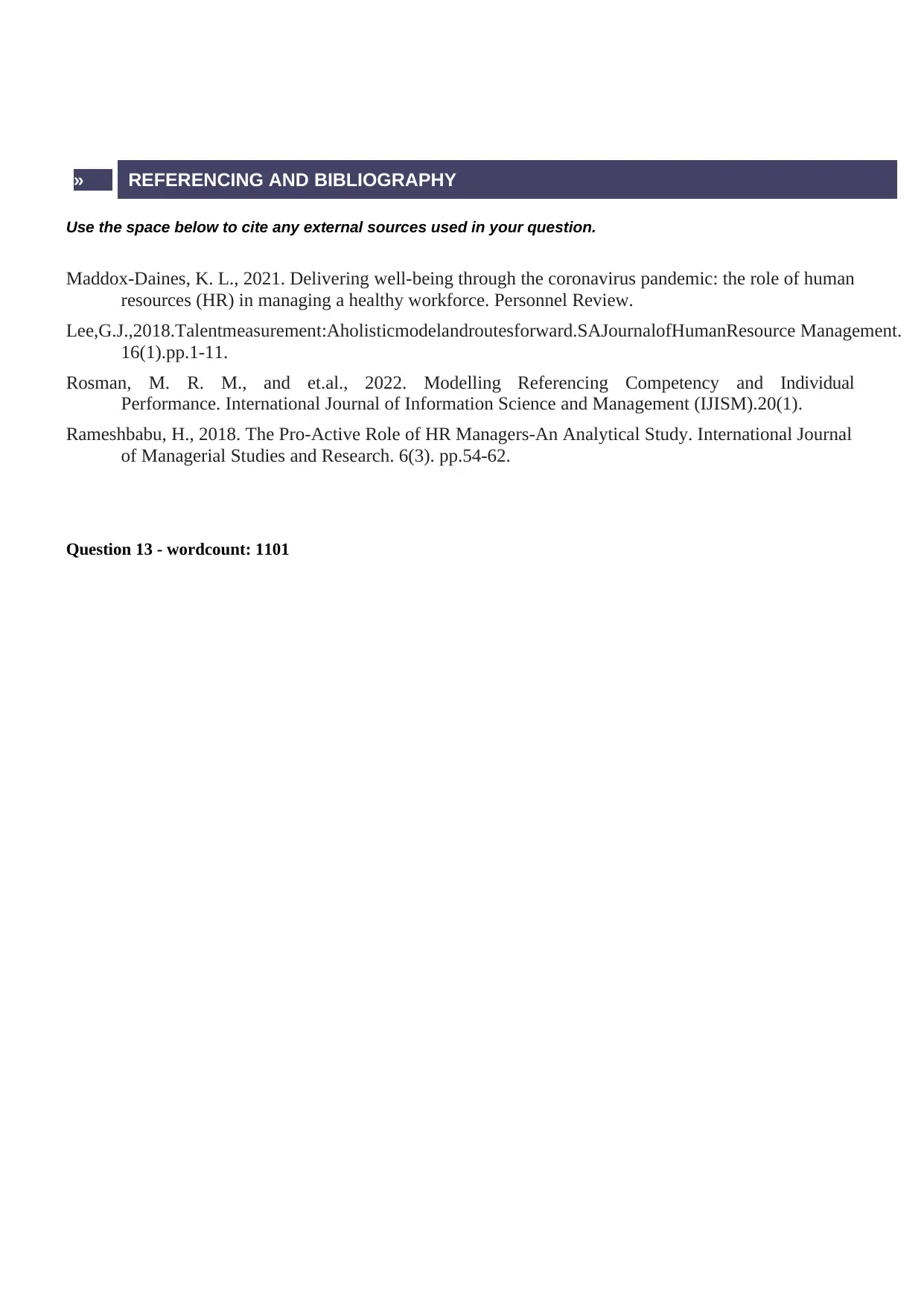
» REFERENCING AND BIBLIOGRAPHY
Use the space below to cite any external sources used in your question.
Maddox-Daines, K. L., 2021. Delivering well-being through the coronavirus pandemic: the role of human
resources (HR) in managing a healthy workforce. Personnel Review.
Lee,G.J.,2018.Talentmeasurement:Aholisticmodelandroutesforward.SAJournalofHumanResource Management.
16(1).pp.1-11.
Rosman, M. R. M., and et.al., 2022. Modelling Referencing Competency and Individual
Performance. International Journal of Information Science and Management (IJISM).20(1).
Rameshbabu, H., 2018. The Pro-Active Role of HR Managers-An Analytical Study. International Journal
of Managerial Studies and Research. 6(3). pp.54-62.
Question 13 - wordcount: 1101
Use the space below to cite any external sources used in your question.
Maddox-Daines, K. L., 2021. Delivering well-being through the coronavirus pandemic: the role of human
resources (HR) in managing a healthy workforce. Personnel Review.
Lee,G.J.,2018.Talentmeasurement:Aholisticmodelandroutesforward.SAJournalofHumanResource Management.
16(1).pp.1-11.
Rosman, M. R. M., and et.al., 2022. Modelling Referencing Competency and Individual
Performance. International Journal of Information Science and Management (IJISM).20(1).
Rameshbabu, H., 2018. The Pro-Active Role of HR Managers-An Analytical Study. International Journal
of Managerial Studies and Research. 6(3). pp.54-62.
Question 13 - wordcount: 1101
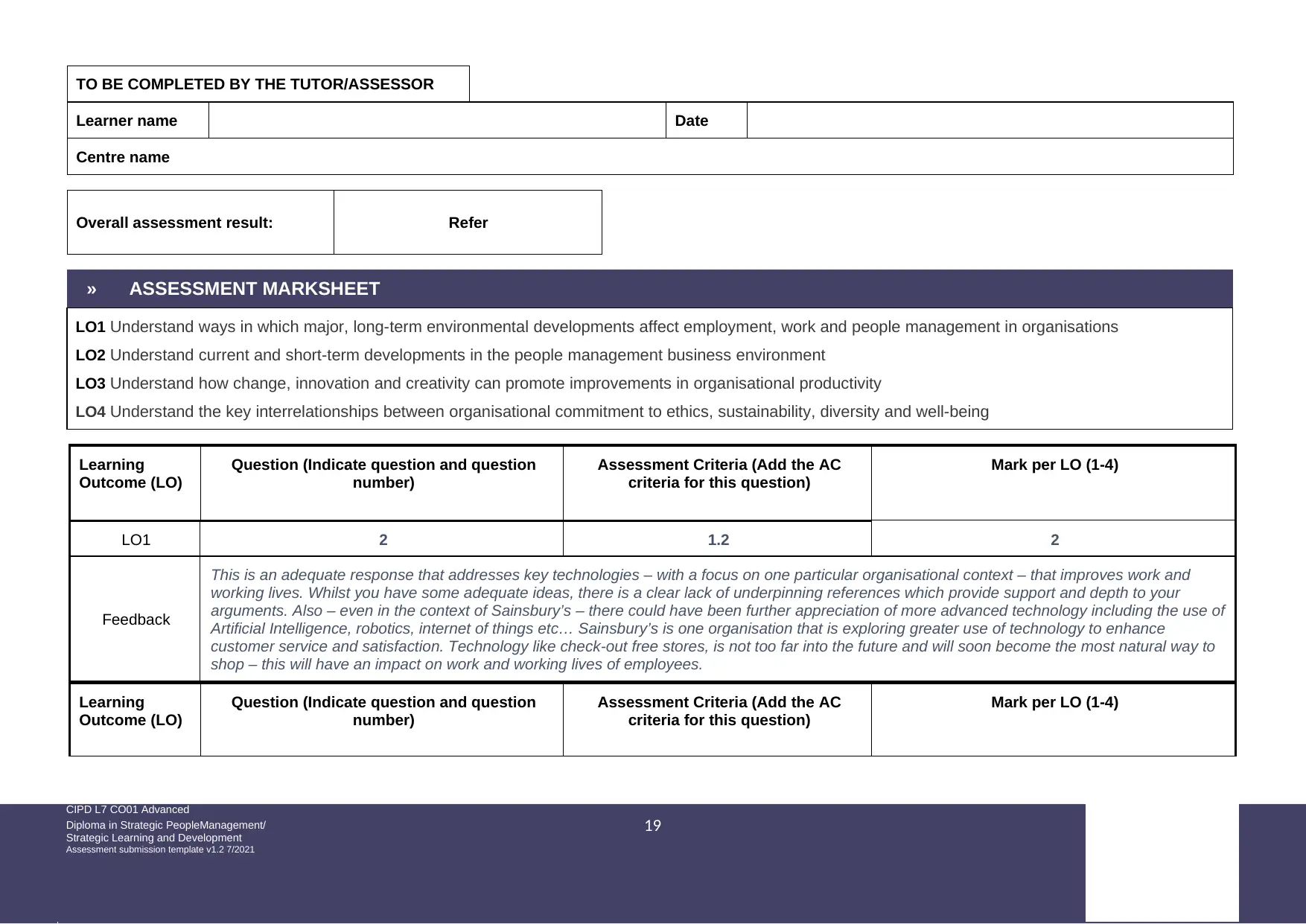
TO BE COMPLETED BY THE TUTOR/ASSESSOR
Learner name Date
Centre name
Overall assessment result: Refer
» ASSESSMENT MARKSHEET
LO1 Understand ways in which major, long-term environmental developments affect employment, work and people management in organisations
LO2 Understand current and short-term developments in the people management business environment
LO3 Understand how change, innovation and creativity can promote improvements in organisational productivity
LO4 Understand the key interrelationships between organisational commitment to ethics, sustainability, diversity and well-being
Learning
Outcome (LO)
Question (Indicate question and question
number)
Assessment Criteria (Add the AC
criteria for this question)
Mark per LO (1-4)
LO1 2 1.2 2
Feedback
This is an adequate response that addresses key technologies – with a focus on one particular organisational context – that improves work and
working lives. Whilst you have some adequate ideas, there is a clear lack of underpinning references which provide support and depth to your
arguments. Also – even in the context of Sainsbury’s – there could have been further appreciation of more advanced technology including the use of
Artificial Intelligence, robotics, internet of things etc… Sainsbury’s is one organisation that is exploring greater use of technology to enhance
customer service and satisfaction. Technology like check-out free stores, is not too far into the future and will soon become the most natural way to
shop – this will have an impact on work and working lives of employees.
Learning
Outcome (LO)
Question (Indicate question and question
number)
Assessment Criteria (Add the AC
criteria for this question)
Mark per LO (1-4)
CIPD L7 CO01 Advanced
Diploma in Strategic PeopleManagement/ 19
Strategic Learning and Development
Assessment submission template v1.2 7/2021
Learner name Date
Centre name
Overall assessment result: Refer
» ASSESSMENT MARKSHEET
LO1 Understand ways in which major, long-term environmental developments affect employment, work and people management in organisations
LO2 Understand current and short-term developments in the people management business environment
LO3 Understand how change, innovation and creativity can promote improvements in organisational productivity
LO4 Understand the key interrelationships between organisational commitment to ethics, sustainability, diversity and well-being
Learning
Outcome (LO)
Question (Indicate question and question
number)
Assessment Criteria (Add the AC
criteria for this question)
Mark per LO (1-4)
LO1 2 1.2 2
Feedback
This is an adequate response that addresses key technologies – with a focus on one particular organisational context – that improves work and
working lives. Whilst you have some adequate ideas, there is a clear lack of underpinning references which provide support and depth to your
arguments. Also – even in the context of Sainsbury’s – there could have been further appreciation of more advanced technology including the use of
Artificial Intelligence, robotics, internet of things etc… Sainsbury’s is one organisation that is exploring greater use of technology to enhance
customer service and satisfaction. Technology like check-out free stores, is not too far into the future and will soon become the most natural way to
shop – this will have an impact on work and working lives of employees.
Learning
Outcome (LO)
Question (Indicate question and question
number)
Assessment Criteria (Add the AC
criteria for this question)
Mark per LO (1-4)
CIPD L7 CO01 Advanced
Diploma in Strategic PeopleManagement/ 19
Strategic Learning and Development
Assessment submission template v1.2 7/2021
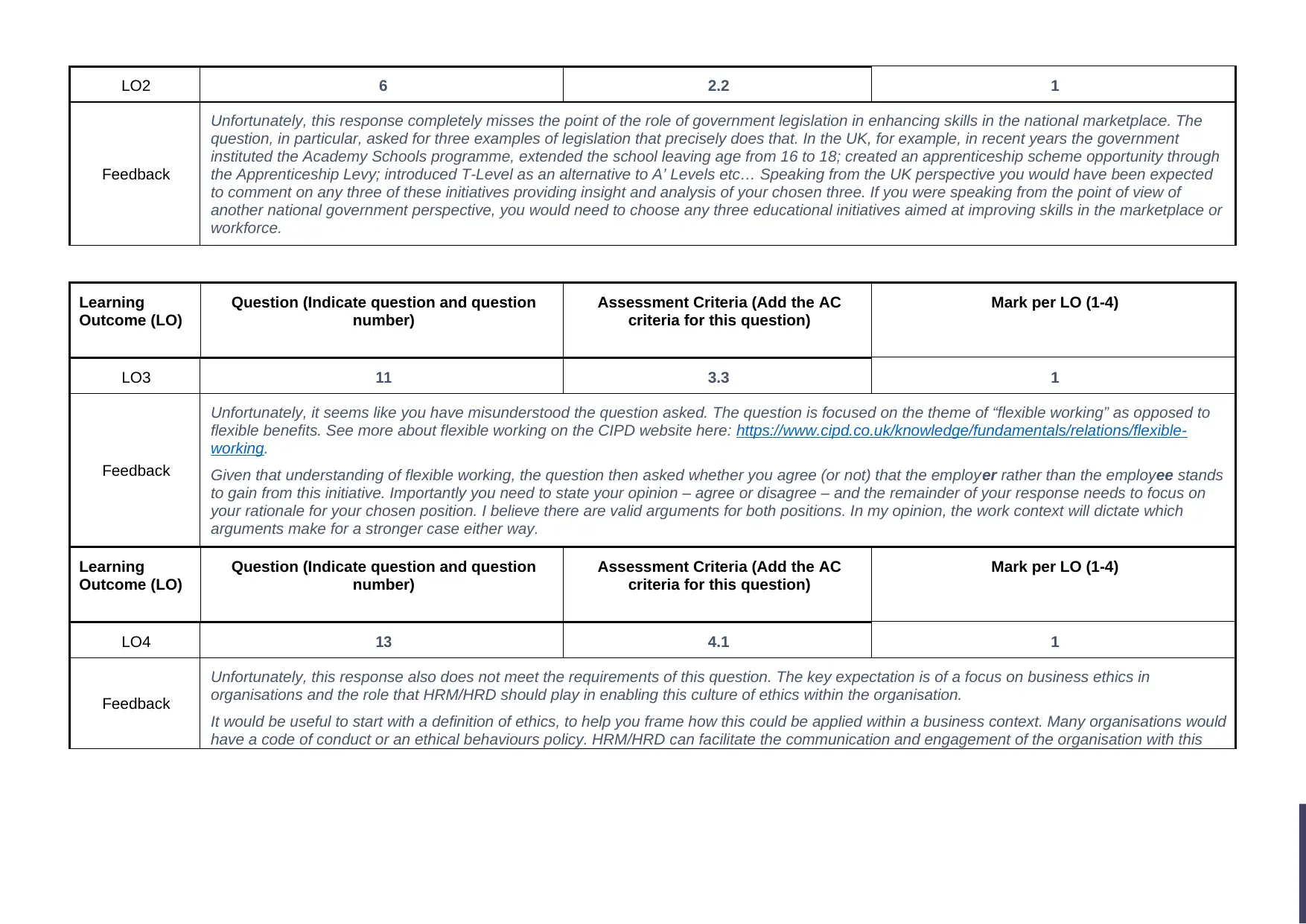
LO2 6 2.2 1
Feedback
Unfortunately, this response completely misses the point of the role of government legislation in enhancing skills in the national marketplace. The
question, in particular, asked for three examples of legislation that precisely does that. In the UK, for example, in recent years the government
instituted the Academy Schools programme, extended the school leaving age from 16 to 18; created an apprenticeship scheme opportunity through
the Apprenticeship Levy; introduced T-Level as an alternative to A’ Levels etc… Speaking from the UK perspective you would have been expected
to comment on any three of these initiatives providing insight and analysis of your chosen three. If you were speaking from the point of view of
another national government perspective, you would need to choose any three educational initiatives aimed at improving skills in the marketplace or
workforce.
Learning
Outcome (LO)
Question (Indicate question and question
number)
Assessment Criteria (Add the AC
criteria for this question)
Mark per LO (1-4)
LO3 11 3.3 1
Feedback
Unfortunately, it seems like you have misunderstood the question asked. The question is focused on the theme of “flexible working” as opposed to
flexible benefits. See more about flexible working on the CIPD website here: https://www.cipd.co.uk/knowledge/fundamentals/relations/flexible-
working.
Given that understanding of flexible working, the question then asked whether you agree (or not) that the employer rather than the employee stands
to gain from this initiative. Importantly you need to state your opinion – agree or disagree – and the remainder of your response needs to focus on
your rationale for your chosen position. I believe there are valid arguments for both positions. In my opinion, the work context will dictate which
arguments make for a stronger case either way.
Learning
Outcome (LO)
Question (Indicate question and question
number)
Assessment Criteria (Add the AC
criteria for this question)
Mark per LO (1-4)
LO4 13 4.1 1
Feedback
Unfortunately, this response also does not meet the requirements of this question. The key expectation is of a focus on business ethics in
organisations and the role that HRM/HRD should play in enabling this culture of ethics within the organisation.
It would be useful to start with a definition of ethics, to help you frame how this could be applied within a business context. Many organisations would
have a code of conduct or an ethical behaviours policy. HRM/HRD can facilitate the communication and engagement of the organisation with this
Feedback
Unfortunately, this response completely misses the point of the role of government legislation in enhancing skills in the national marketplace. The
question, in particular, asked for three examples of legislation that precisely does that. In the UK, for example, in recent years the government
instituted the Academy Schools programme, extended the school leaving age from 16 to 18; created an apprenticeship scheme opportunity through
the Apprenticeship Levy; introduced T-Level as an alternative to A’ Levels etc… Speaking from the UK perspective you would have been expected
to comment on any three of these initiatives providing insight and analysis of your chosen three. If you were speaking from the point of view of
another national government perspective, you would need to choose any three educational initiatives aimed at improving skills in the marketplace or
workforce.
Learning
Outcome (LO)
Question (Indicate question and question
number)
Assessment Criteria (Add the AC
criteria for this question)
Mark per LO (1-4)
LO3 11 3.3 1
Feedback
Unfortunately, it seems like you have misunderstood the question asked. The question is focused on the theme of “flexible working” as opposed to
flexible benefits. See more about flexible working on the CIPD website here: https://www.cipd.co.uk/knowledge/fundamentals/relations/flexible-
working.
Given that understanding of flexible working, the question then asked whether you agree (or not) that the employer rather than the employee stands
to gain from this initiative. Importantly you need to state your opinion – agree or disagree – and the remainder of your response needs to focus on
your rationale for your chosen position. I believe there are valid arguments for both positions. In my opinion, the work context will dictate which
arguments make for a stronger case either way.
Learning
Outcome (LO)
Question (Indicate question and question
number)
Assessment Criteria (Add the AC
criteria for this question)
Mark per LO (1-4)
LO4 13 4.1 1
Feedback
Unfortunately, this response also does not meet the requirements of this question. The key expectation is of a focus on business ethics in
organisations and the role that HRM/HRD should play in enabling this culture of ethics within the organisation.
It would be useful to start with a definition of ethics, to help you frame how this could be applied within a business context. Many organisations would
have a code of conduct or an ethical behaviours policy. HRM/HRD can facilitate the communication and engagement of the organisation with this
Secure Best Marks with AI Grader
Need help grading? Try our AI Grader for instant feedback on your assignments.
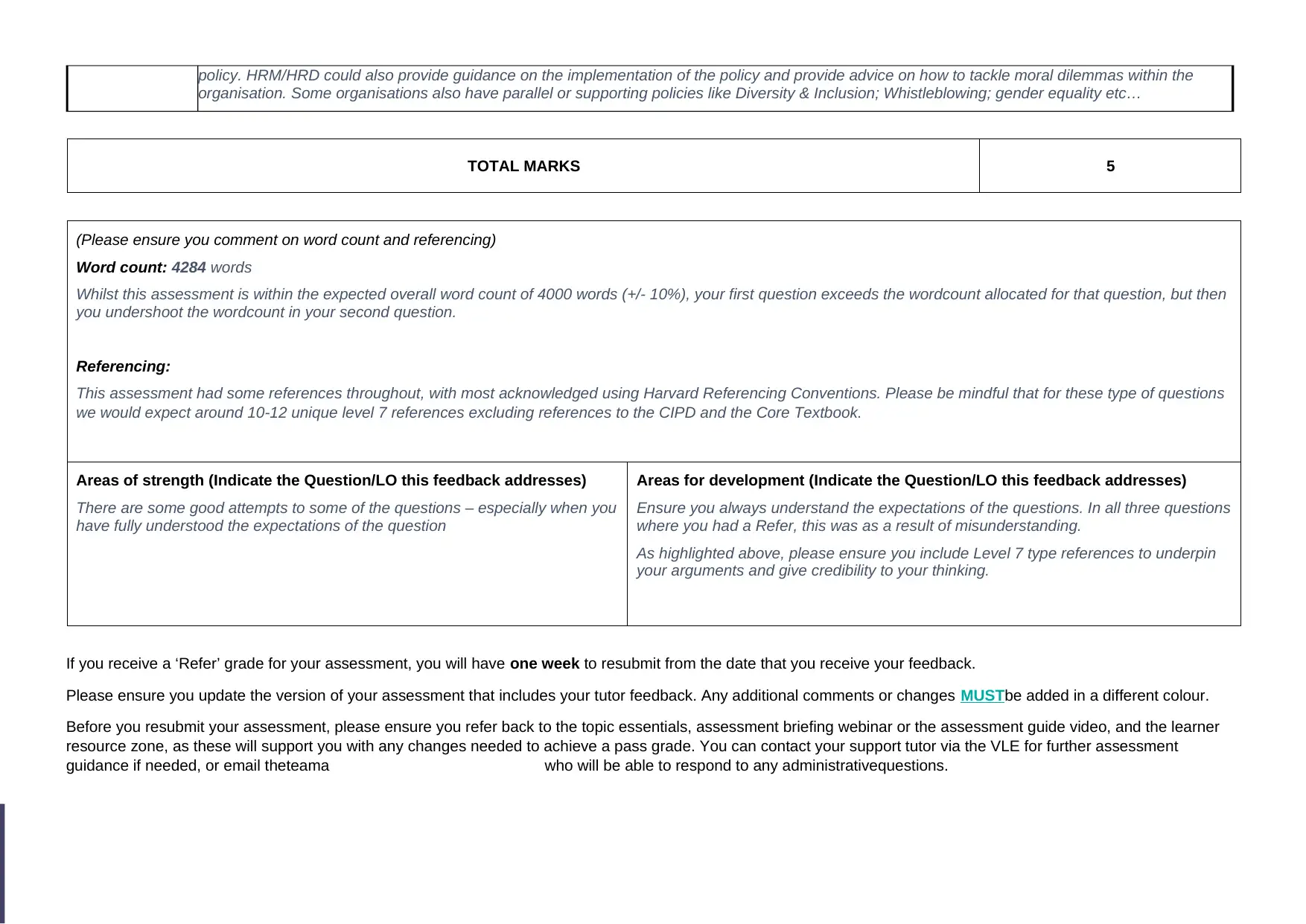
TOTAL MARKS 5
(Please ensure you comment on word count and referencing)
Word count: 4284 words
Whilst this assessment is within the expected overall word count of 4000 words (+/- 10%), your first question exceeds the wordcount allocated for that question, but then
you undershoot the wordcount in your second question.
Referencing:
This assessment had some references throughout, with most acknowledged using Harvard Referencing Conventions. Please be mindful that for these type of questions
we would expect around 10-12 unique level 7 references excluding references to the CIPD and the Core Textbook.
Areas of strength (Indicate the Question/LO this feedback addresses)
There are some good attempts to some of the questions – especially when you
have fully understood the expectations of the question
Areas for development (Indicate the Question/LO this feedback addresses)
Ensure you always understand the expectations of the questions. In all three questions
where you had a Refer, this was as a result of misunderstanding.
As highlighted above, please ensure you include Level 7 type references to underpin
your arguments and give credibility to your thinking.
If you receive a ‘Refer’ grade for your assessment, you will have one week to resubmit from the date that you receive your feedback.
Please ensure you update the version of your assessment that includes your tutor feedback. Any additional comments or changes MUSTbe added in a different colour.
Before you resubmit your assessment, please ensure you refer back to the topic essentials, assessment briefing webinar or the assessment guide video, and the learner
resource zone, as these will support you with any changes needed to achieve a pass grade. You can contact your support tutor via the VLE for further assessment
guidance if needed, or email theteama who will be able to respond to any administrativequestions.
policy. HRM/HRD could also provide guidance on the implementation of the policy and provide advice on how to tackle moral dilemmas within the
organisation. Some organisations also have parallel or supporting policies like Diversity & Inclusion; Whistleblowing; gender equality etc…
(Please ensure you comment on word count and referencing)
Word count: 4284 words
Whilst this assessment is within the expected overall word count of 4000 words (+/- 10%), your first question exceeds the wordcount allocated for that question, but then
you undershoot the wordcount in your second question.
Referencing:
This assessment had some references throughout, with most acknowledged using Harvard Referencing Conventions. Please be mindful that for these type of questions
we would expect around 10-12 unique level 7 references excluding references to the CIPD and the Core Textbook.
Areas of strength (Indicate the Question/LO this feedback addresses)
There are some good attempts to some of the questions – especially when you
have fully understood the expectations of the question
Areas for development (Indicate the Question/LO this feedback addresses)
Ensure you always understand the expectations of the questions. In all three questions
where you had a Refer, this was as a result of misunderstanding.
As highlighted above, please ensure you include Level 7 type references to underpin
your arguments and give credibility to your thinking.
If you receive a ‘Refer’ grade for your assessment, you will have one week to resubmit from the date that you receive your feedback.
Please ensure you update the version of your assessment that includes your tutor feedback. Any additional comments or changes MUSTbe added in a different colour.
Before you resubmit your assessment, please ensure you refer back to the topic essentials, assessment briefing webinar or the assessment guide video, and the learner
resource zone, as these will support you with any changes needed to achieve a pass grade. You can contact your support tutor via the VLE for further assessment
guidance if needed, or email theteama who will be able to respond to any administrativequestions.
policy. HRM/HRD could also provide guidance on the implementation of the policy and provide advice on how to tackle moral dilemmas within the
organisation. Some organisations also have parallel or supporting policies like Diversity & Inclusion; Whistleblowing; gender equality etc…
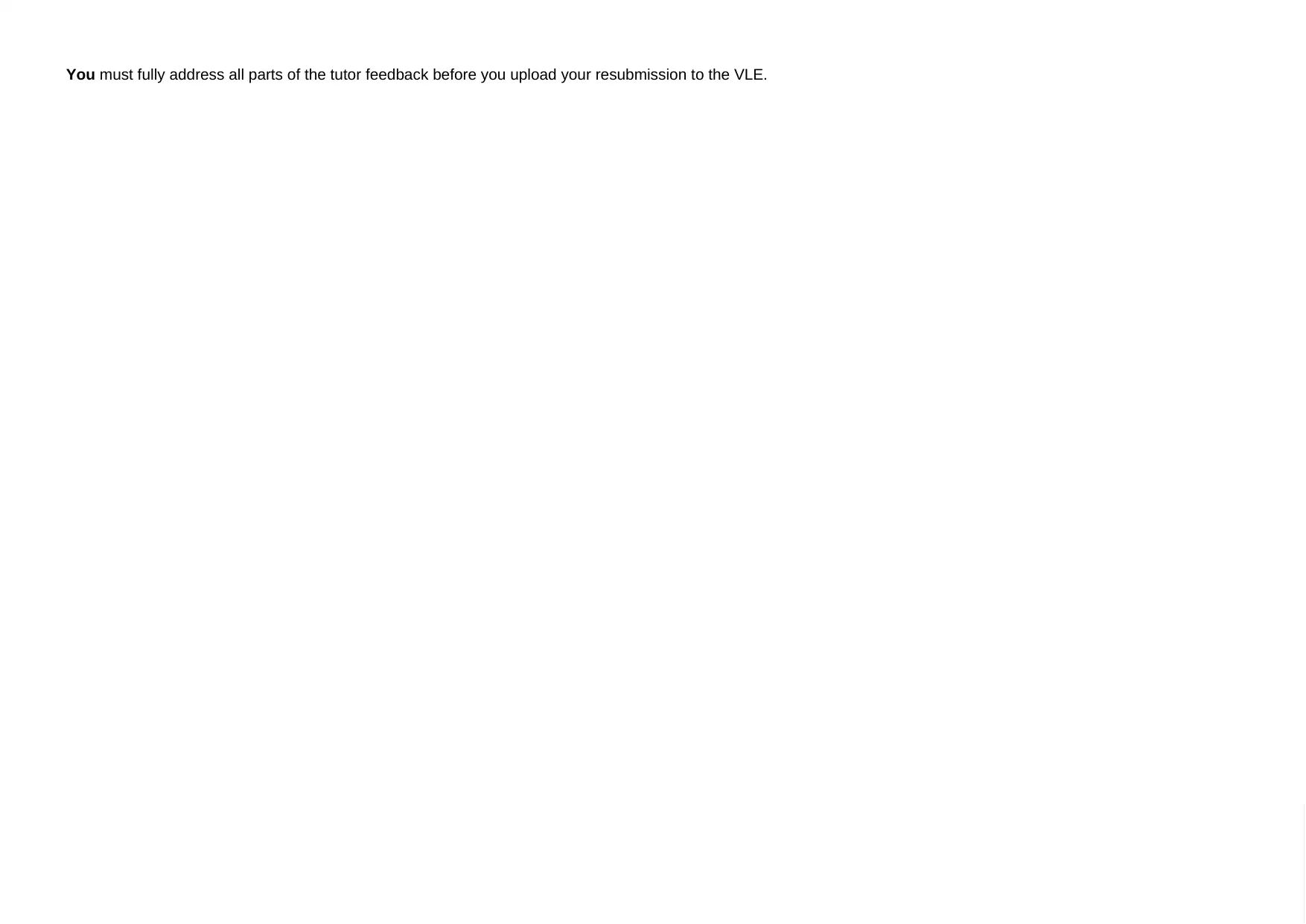
You must fully address all parts of the tutor feedback before you upload your resubmission to the VLE.
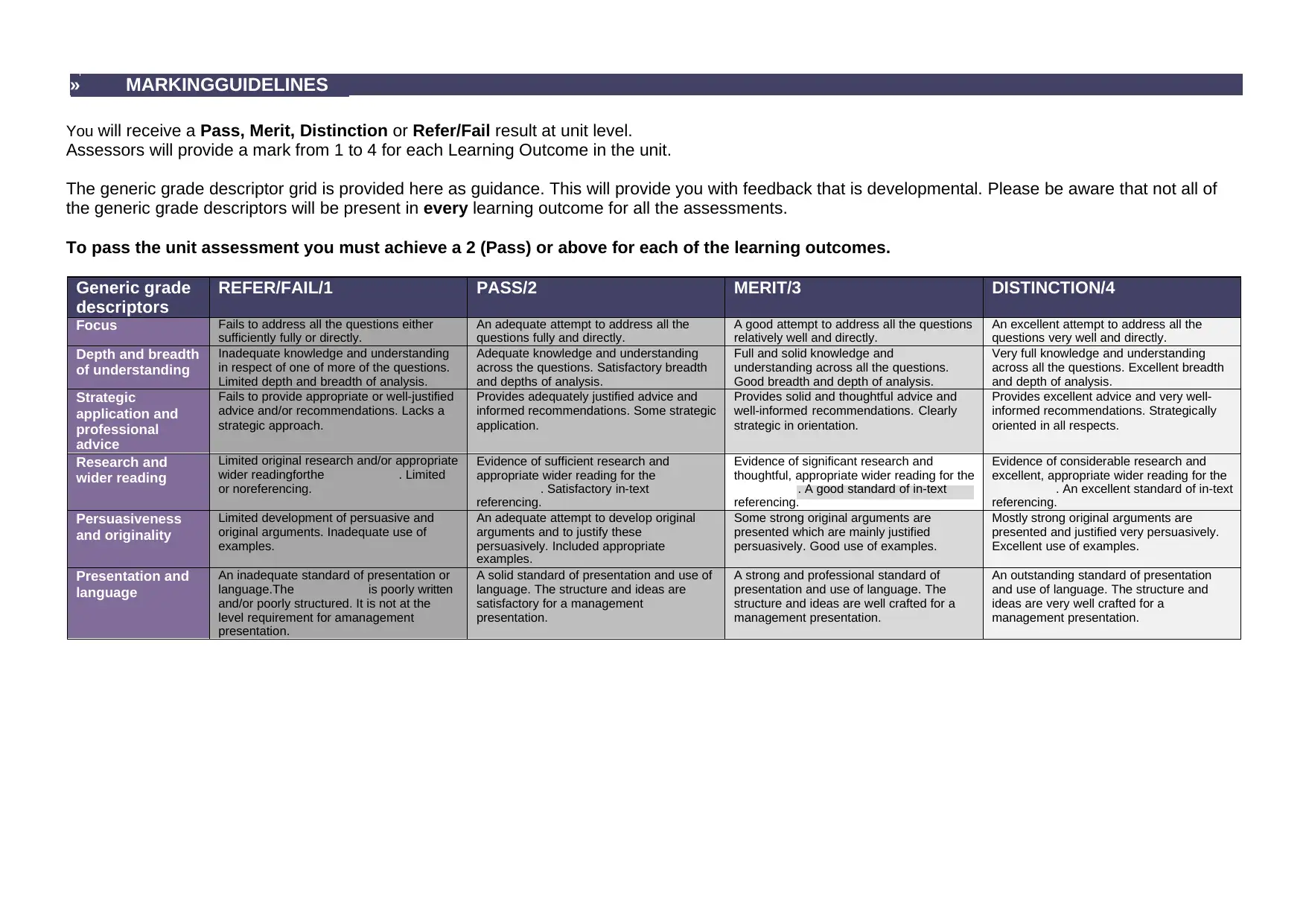
» MARKINGGUIDELINES
You will receive a Pass, Merit, Distinction or Refer/Fail result at unit level.
Assessors will provide a mark from 1 to 4 for each Learning Outcome in the unit.
The generic grade descriptor grid is provided here as guidance. This will provide you with feedback that is developmental. Please be aware that not all of
the generic grade descriptors will be present in every learning outcome for all the assessments.
To pass the unit assessment you must achieve a 2 (Pass) or above for each of the learning outcomes.
Generic grade
descriptors
REFER/FAIL/1 PASS/2 MERIT/3 DISTINCTION/4
Focus Fails to address all the questions either
sufficiently fully or directly.
An adequate attempt to address all the
questions fully and directly.
A good attempt to address all the questions
relatively well and directly.
An excellent attempt to address all the
questions very well and directly.
Depth and breadth
of understanding
Inadequate knowledge and understanding
in respect of one of more of the questions.
Limited depth and breadth of analysis.
Adequate knowledge and understanding
across the questions. Satisfactory breadth
and depths of analysis.
Full and solid knowledge and
understanding across all the questions.
Good breadth and depth of analysis.
Very full knowledge and understanding
across all the questions. Excellent breadth
and depth of analysis.
Strategic
application and
professional
advice
Fails to provide appropriate or well-justified
advice and/or recommendations. Lacks a
strategic approach.
Provides adequately justified advice and
informed recommendations. Some strategic
application.
Provides solid and thoughtful advice and
well-informed recommendations. Clearly
strategic in orientation.
Provides excellent advice and very well-
informed recommendations. Strategically
oriented in all respects.
Research and
wider reading
Limited original research and/or appropriate
wider readingforthe . Limited
or noreferencing.
Evidence of sufficient research and
appropriate wider reading for the
. Satisfactory in-text
referencing.
Evidence of significant research and
thoughtful, appropriate wider reading for the
. A good standard of in-text
referencing.
Evidence of considerable research and
excellent, appropriate wider reading for the
. An excellent standard of in-text
referencing.
Persuasiveness
and originality
Limited development of persuasive and
original arguments. Inadequate use of
examples.
An adequate attempt to develop original
arguments and to justify these
persuasively. Included appropriate
examples.
Some strong original arguments are
presented which are mainly justified
persuasively. Good use of examples.
Mostly strong original arguments are
presented and justified very persuasively.
Excellent use of examples.
Presentation and
language
An inadequate standard of presentation or
language.The is poorly written
and/or poorly structured. It is not at the
level requirement for amanagement
presentation.
A solid standard of presentation and use of
language. The structure and ideas are
satisfactory for a management
presentation.
A strong and professional standard of
presentation and use of language. The
structure and ideas are well crafted for a
management presentation.
An outstanding standard of presentation
and use of language. The structure and
ideas are very well crafted for a
management presentation.
You will receive a Pass, Merit, Distinction or Refer/Fail result at unit level.
Assessors will provide a mark from 1 to 4 for each Learning Outcome in the unit.
The generic grade descriptor grid is provided here as guidance. This will provide you with feedback that is developmental. Please be aware that not all of
the generic grade descriptors will be present in every learning outcome for all the assessments.
To pass the unit assessment you must achieve a 2 (Pass) or above for each of the learning outcomes.
Generic grade
descriptors
REFER/FAIL/1 PASS/2 MERIT/3 DISTINCTION/4
Focus Fails to address all the questions either
sufficiently fully or directly.
An adequate attempt to address all the
questions fully and directly.
A good attempt to address all the questions
relatively well and directly.
An excellent attempt to address all the
questions very well and directly.
Depth and breadth
of understanding
Inadequate knowledge and understanding
in respect of one of more of the questions.
Limited depth and breadth of analysis.
Adequate knowledge and understanding
across the questions. Satisfactory breadth
and depths of analysis.
Full and solid knowledge and
understanding across all the questions.
Good breadth and depth of analysis.
Very full knowledge and understanding
across all the questions. Excellent breadth
and depth of analysis.
Strategic
application and
professional
advice
Fails to provide appropriate or well-justified
advice and/or recommendations. Lacks a
strategic approach.
Provides adequately justified advice and
informed recommendations. Some strategic
application.
Provides solid and thoughtful advice and
well-informed recommendations. Clearly
strategic in orientation.
Provides excellent advice and very well-
informed recommendations. Strategically
oriented in all respects.
Research and
wider reading
Limited original research and/or appropriate
wider readingforthe . Limited
or noreferencing.
Evidence of sufficient research and
appropriate wider reading for the
. Satisfactory in-text
referencing.
Evidence of significant research and
thoughtful, appropriate wider reading for the
. A good standard of in-text
referencing.
Evidence of considerable research and
excellent, appropriate wider reading for the
. An excellent standard of in-text
referencing.
Persuasiveness
and originality
Limited development of persuasive and
original arguments. Inadequate use of
examples.
An adequate attempt to develop original
arguments and to justify these
persuasively. Included appropriate
examples.
Some strong original arguments are
presented which are mainly justified
persuasively. Good use of examples.
Mostly strong original arguments are
presented and justified very persuasively.
Excellent use of examples.
Presentation and
language
An inadequate standard of presentation or
language.The is poorly written
and/or poorly structured. It is not at the
level requirement for amanagement
presentation.
A solid standard of presentation and use of
language. The structure and ideas are
satisfactory for a management
presentation.
A strong and professional standard of
presentation and use of language. The
structure and ideas are well crafted for a
management presentation.
An outstanding standard of presentation
and use of language. The structure and
ideas are very well crafted for a
management presentation.
Paraphrase This Document
Need a fresh take? Get an instant paraphrase of this document with our AI Paraphraser
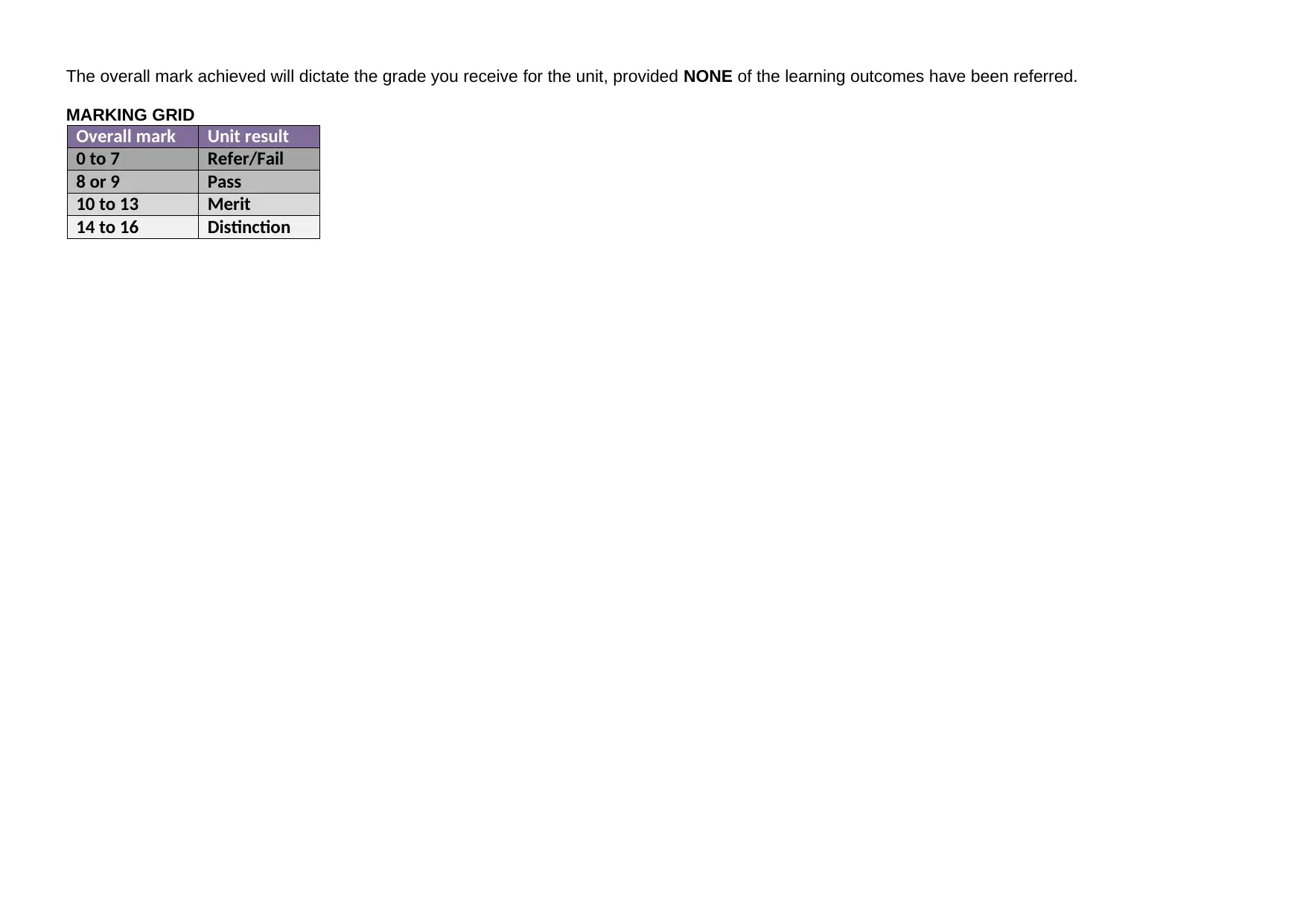
The overall mark achieved will dictate the grade you receive for the unit, provided NONE of the learning outcomes have been referred.
MARKING GRID
Overall mark Unit result
0 to 7 Refer/Fail
8 or 9 Pass
10 to 13 Merit
14 to 16 Distinction
MARKING GRID
Overall mark Unit result
0 to 7 Refer/Fail
8 or 9 Pass
10 to 13 Merit
14 to 16 Distinction
1 out of 26
Related Documents
Your All-in-One AI-Powered Toolkit for Academic Success.
+13062052269
info@desklib.com
Available 24*7 on WhatsApp / Email
![[object Object]](/_next/static/media/star-bottom.7253800d.svg)
Unlock your academic potential
© 2024 | Zucol Services PVT LTD | All rights reserved.





